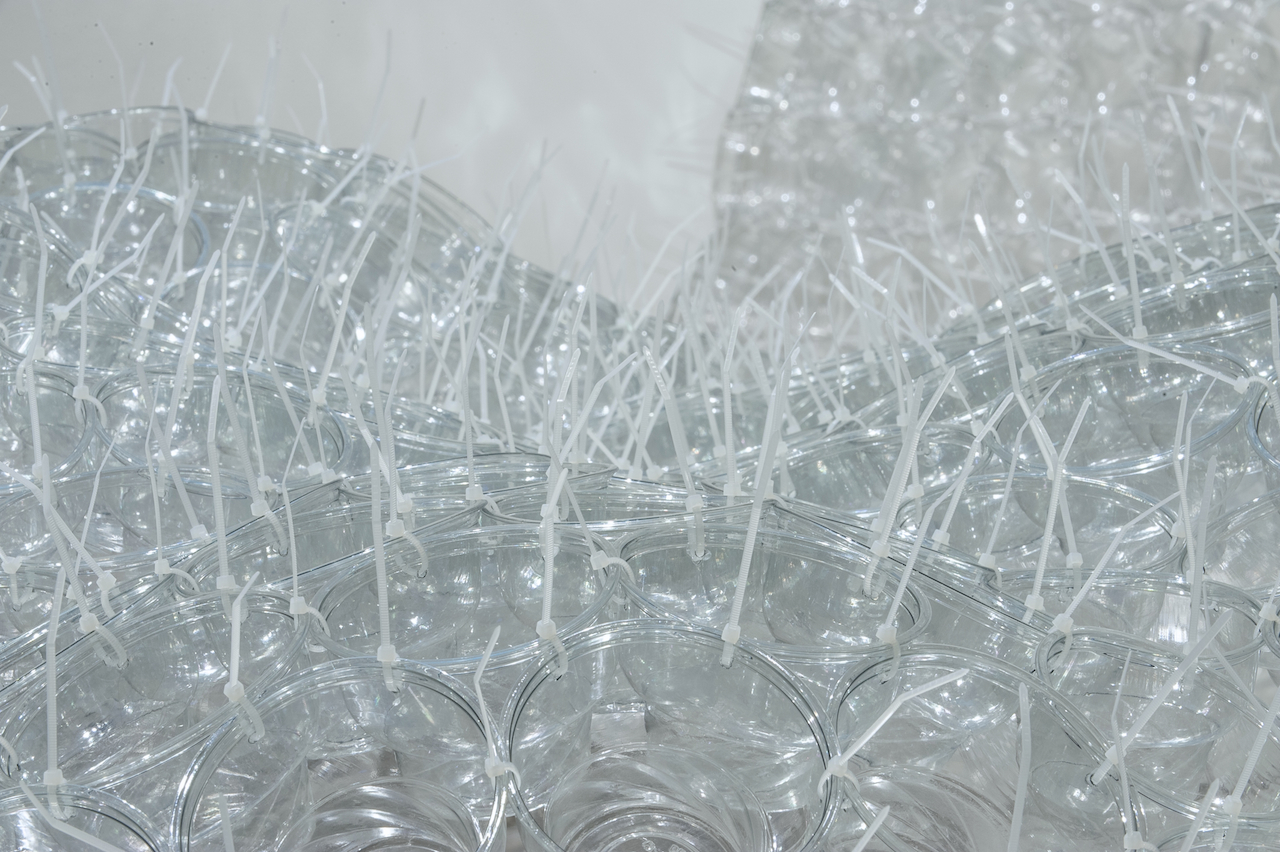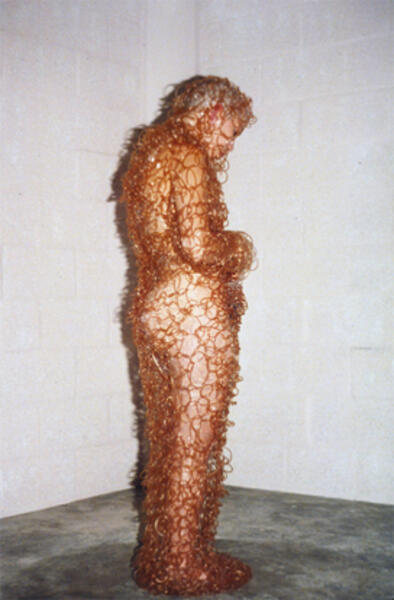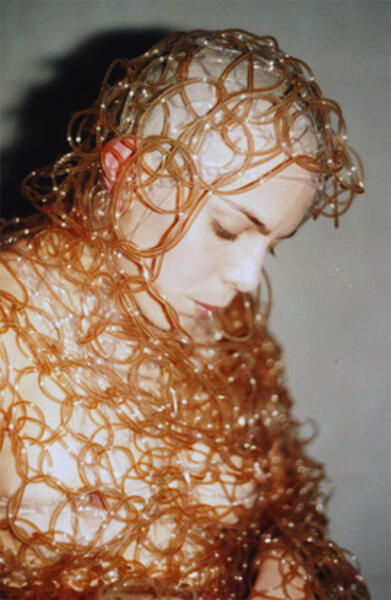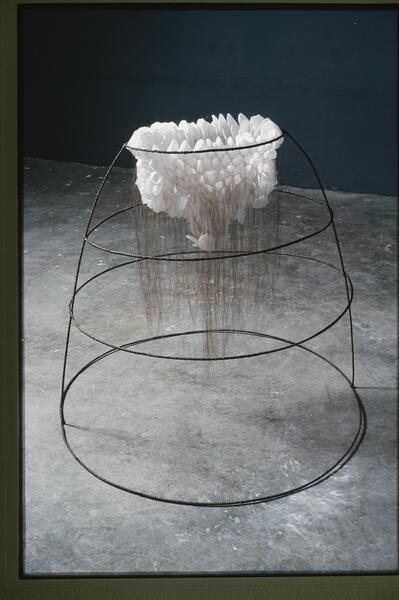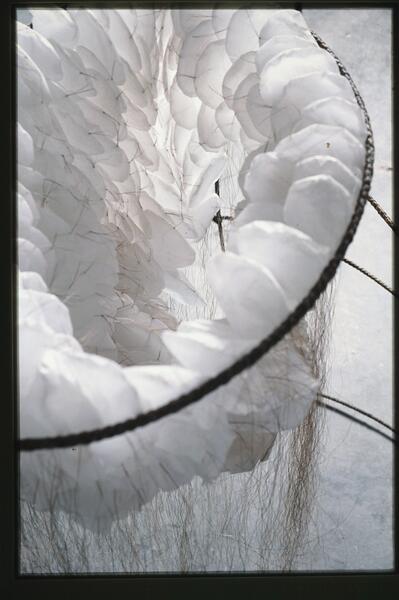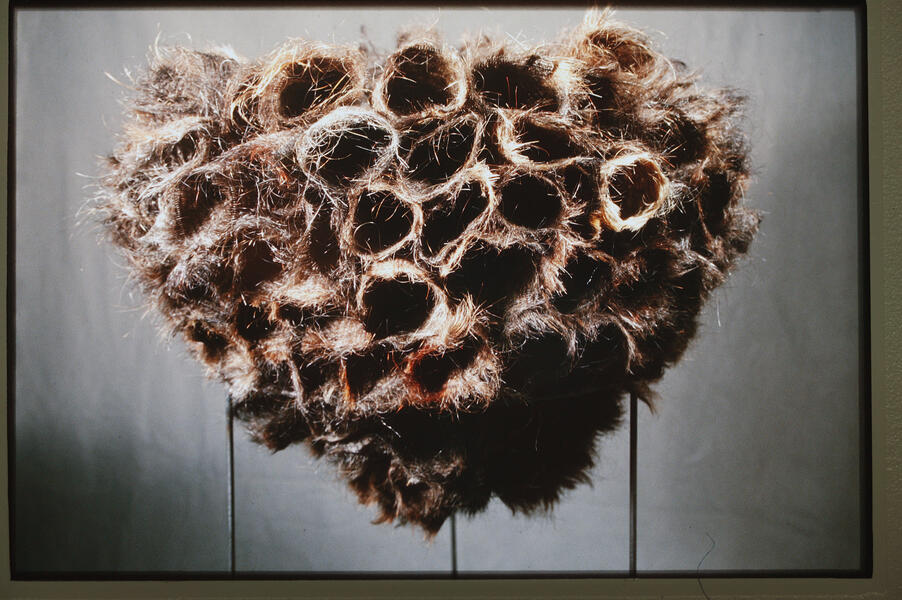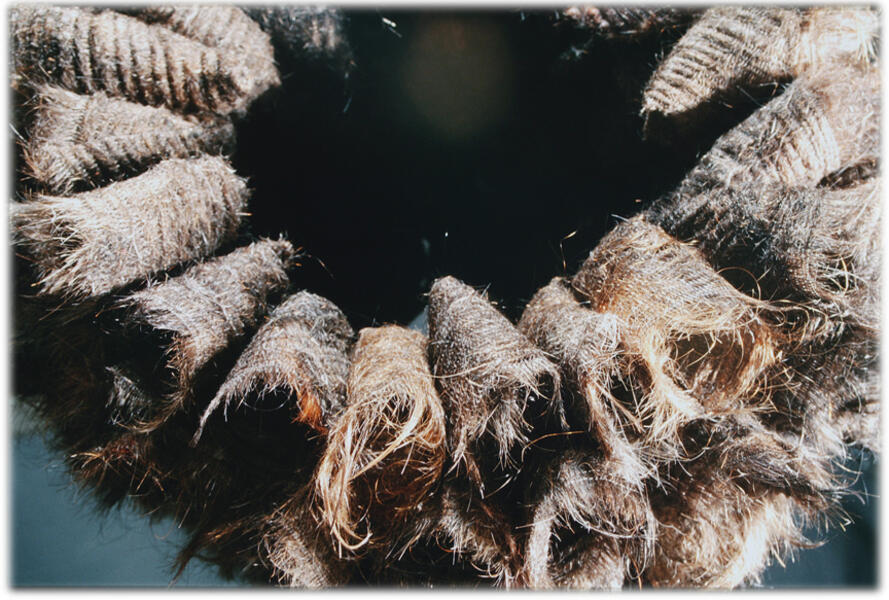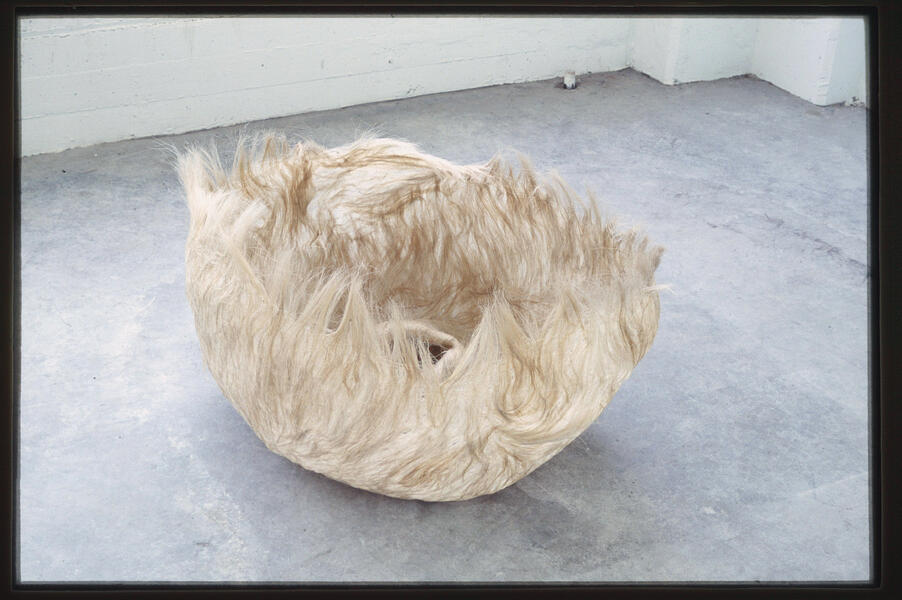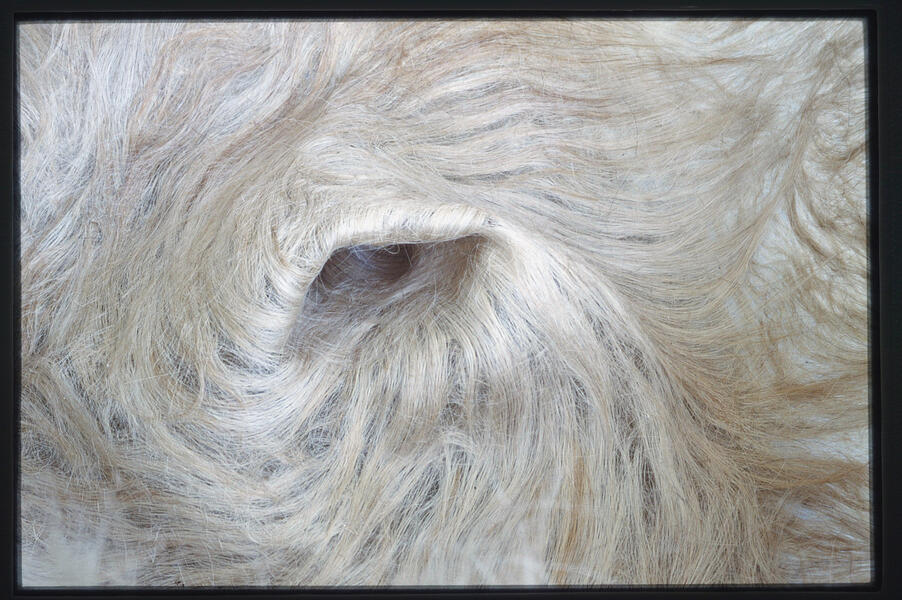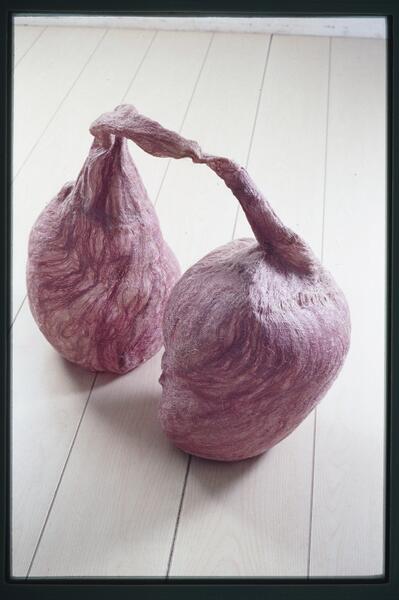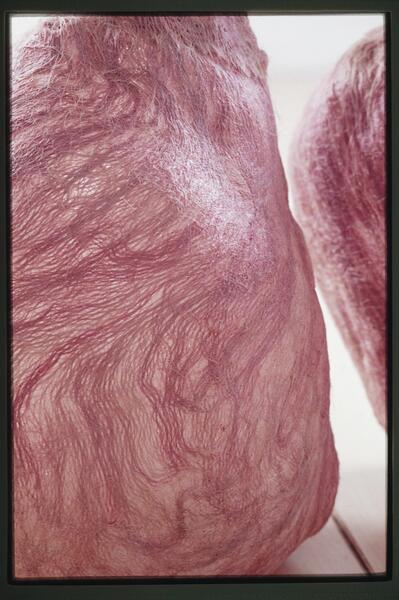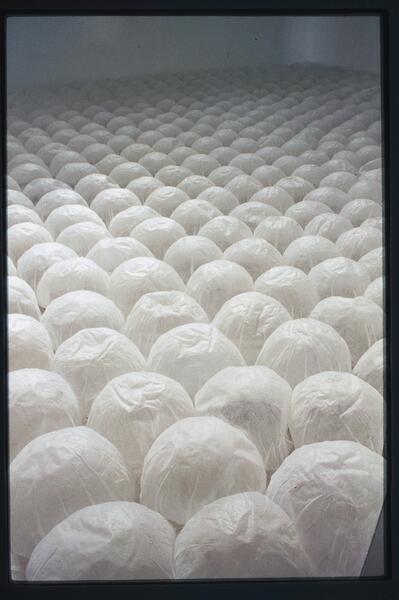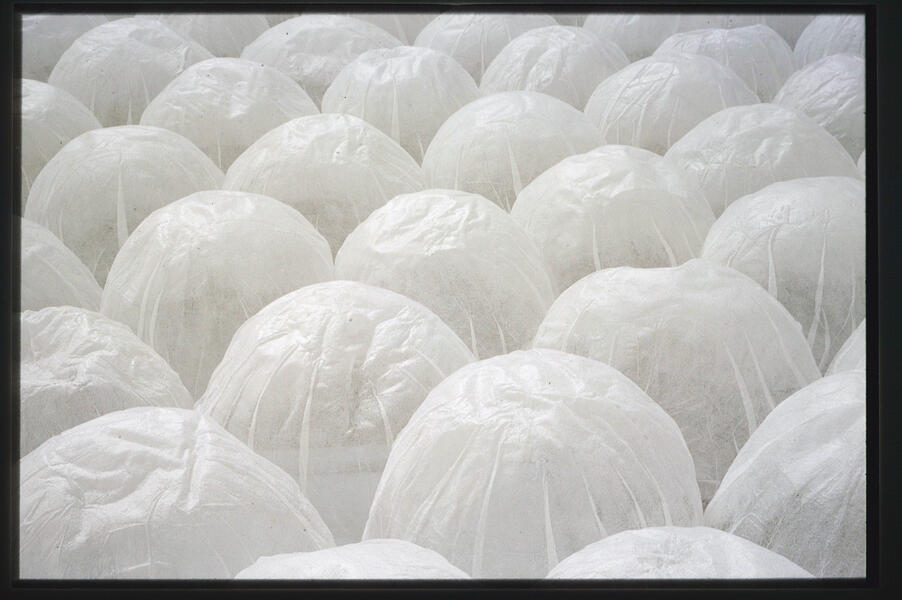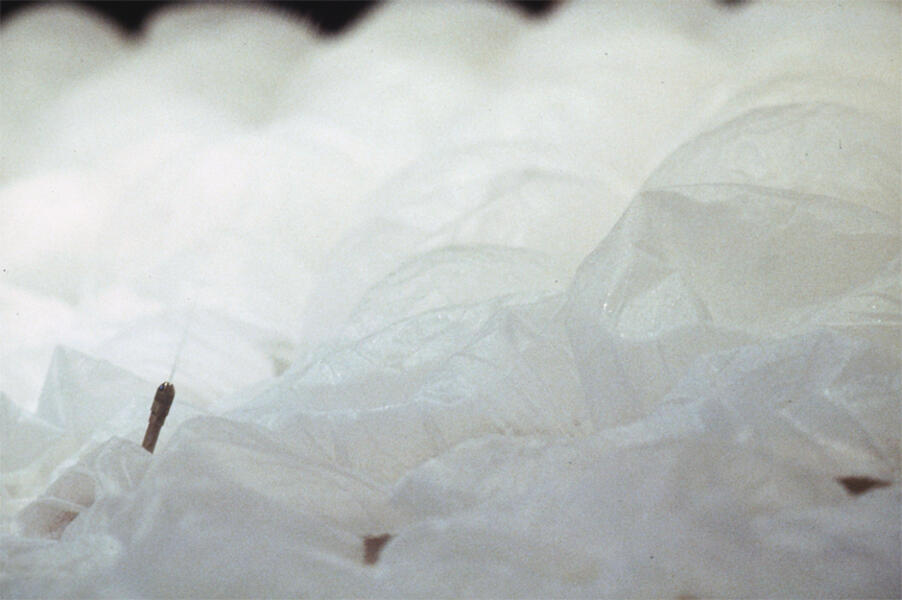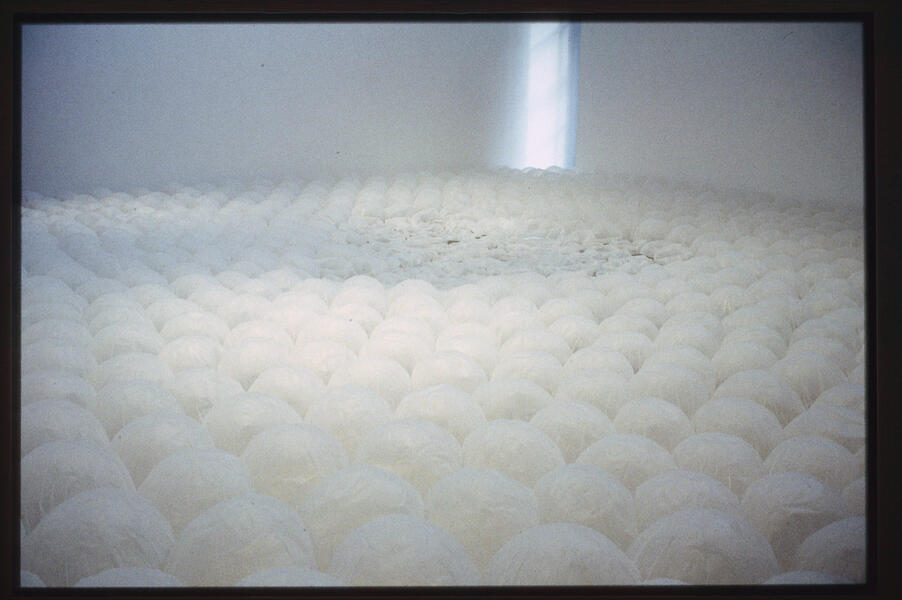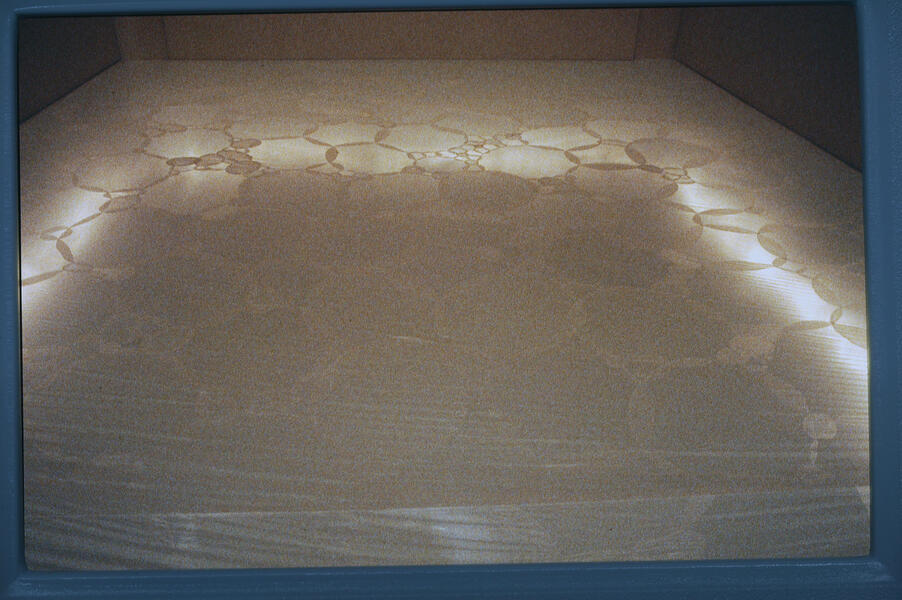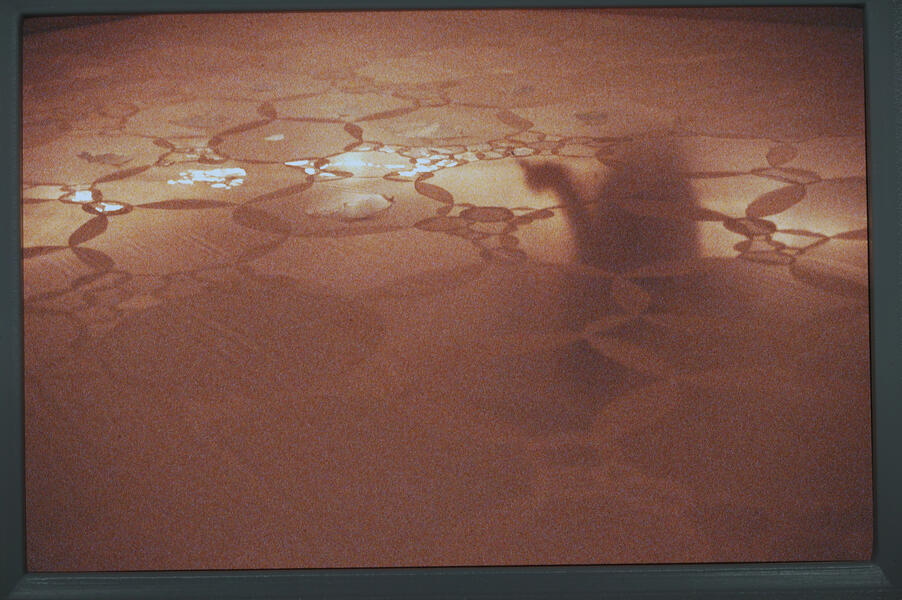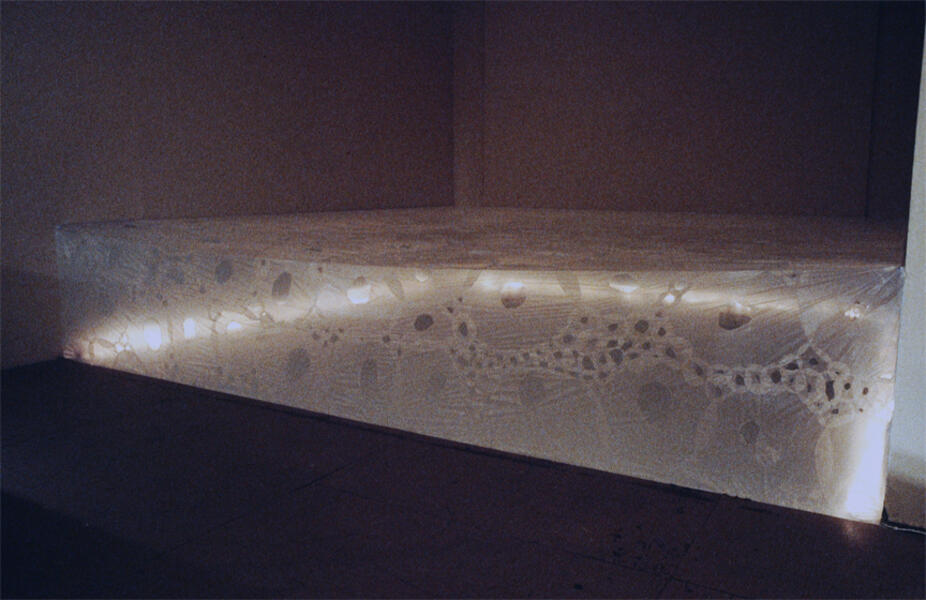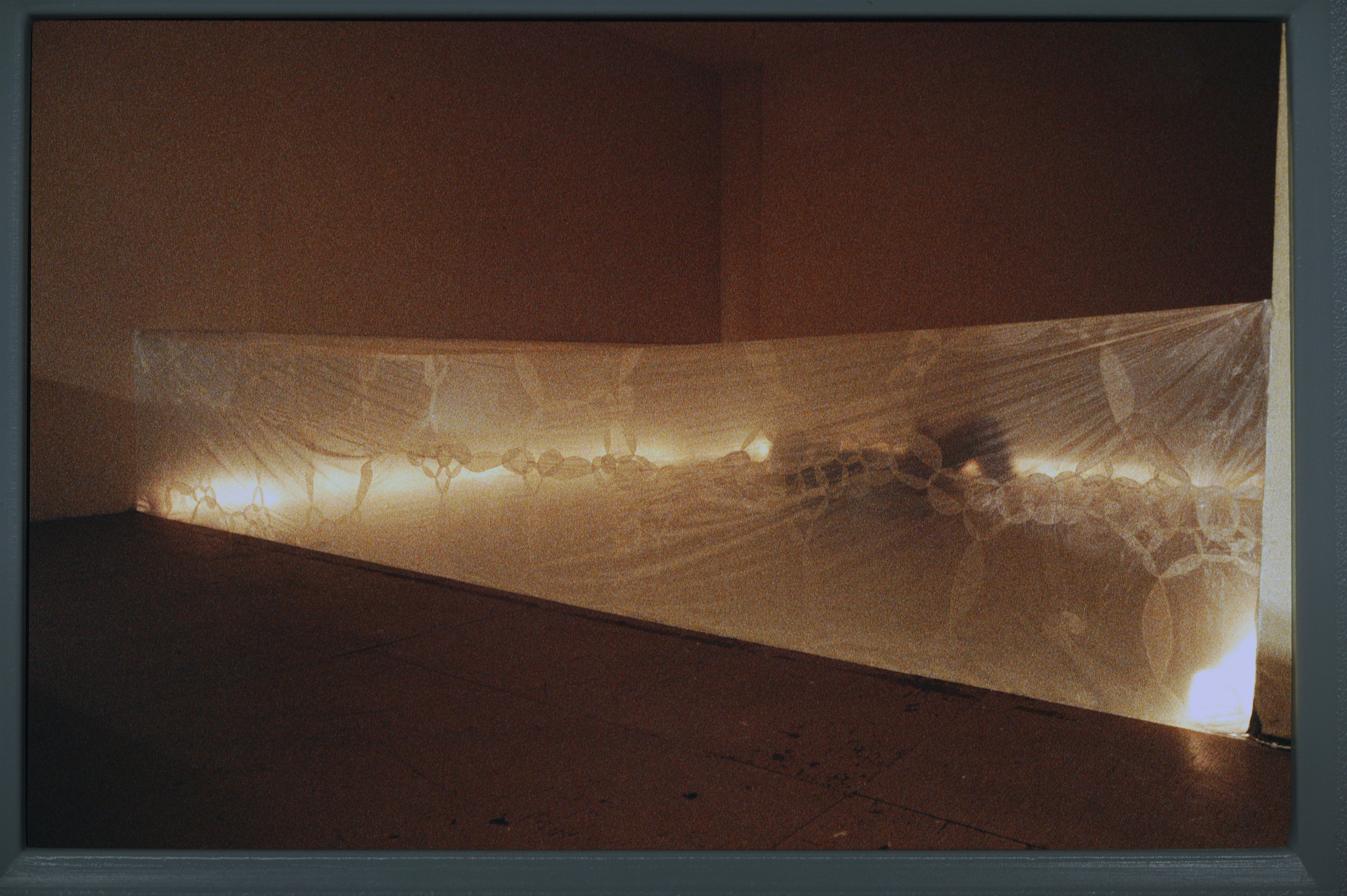Work samples
-
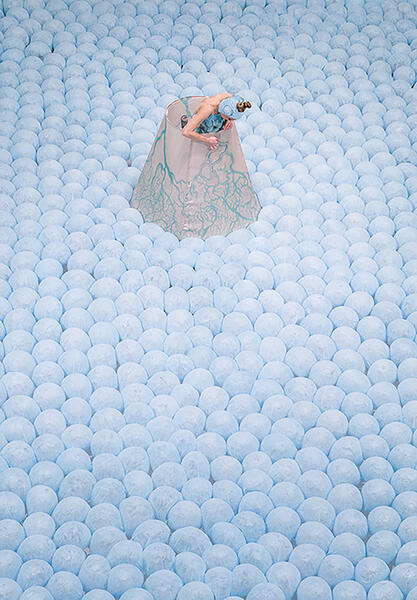 billow4000+ surgical caps were starched and placed on the surface of a monofilament net, supported by a steel armature. In the beginning of the performance I erased a water-soluble ink drawing on fabric. I then retreated below the surface and sprayed water into the air in order to wilt the surrounding field.
billow4000+ surgical caps were starched and placed on the surface of a monofilament net, supported by a steel armature. In the beginning of the performance I erased a water-soluble ink drawing on fabric. I then retreated below the surface and sprayed water into the air in order to wilt the surrounding field.
About renée
Renée Rendine received her BFA from the Maryland Institute College of Art (1996) and an MFA in sculpture from Virginia Commonwealth University (1999). She was a recipient of a Virginia Museum of Fine Arts Fellowship in 2000 and was awarded a fellowship to study in Italy by the Atlantic Center for the Arts that same year. Rendine received a Baker Artist Awards B-Grant in 2015 as well as Maryland Sate Arts council individual Artist Grants in 2005, 2009, and 2016. Selected exhibitions include… more
trace
Inhabiting a dome constructed of embroidery hoops, zip ties, and water-soluble plastic I engaged in performance. From within the structure I used a wet fingertip to melt tiny apertures in the center of each water-soluble plastic membrane. After activating each hoop, I identified those that would reflect my silhoutte if the hoops had been mirrors. Beginning with the hoops that would have been my feet, I enlarged each melted aperature. Once the opening was wide enough, I removed a threaded bobbin from a pocket on my abdomen and launched it through the open hole. The tail of the thread remained anchored to my body by a tiny magnet. I repeated this gesture, launching tethered bobbins through corresponding holes, with each hoop that comprised my standing silhouette. When I completed my task, spools littered the floor outside the sculpture. My make-shift shadow was refracted by chance, rather than light. Delicate red threads emanated from my body, order intact, until they departed the structure. On the gallery floor, they rolled, created tangles, charted new paths, and encountered others who may inadvertantly (or intentionally) alter their paths. I was equal parts marionette and mother, simultanuosly protected and vulnerable.
My garment remained in the sculpture for the duration of the exhibition.
Artist statement:
Insects encase themselves for protection, to create a place where metamorphosis can occur. Utilizing their own secretions, they produce raw materials from which they build. For me, the insect is a metaphor for human behavior. Like insects we are defined by the physical inevitability of our cycles of growth and reproduction, as well as our social need for physical labor.
I have explored these parallels by constructing sculptural costumes that encase my body and resemble cocoons, and then further developed these structures through performance. Exploring the concepts of change and transformation I encase myself in a structure that provides both a covering for my body, as well as a site for an activity. My motion is restricted, and I engage in a repeated action that involves the movement of a material from one part of the structure to another. This process alludes to cannibalism, and also imparts ideas of self-sufficiency implicit in such a closed system.
In one work, entitled Loop, I crocheted a cocoon of tubes to envelop my body like a circulatory system. I sucked on one end of the continuous circuit, drawing fluid from the other end of the long tube, anchored in a pouch on my belly. In another, Seep, my dress extended from my body to become a landscape, its perimeter far beyond my reach. I dipped a 12-foot ladle into a trough of water to slowly dissolve the dress from the hem to the bodice.
In these and in all of my works, the elements are constructed through a laborious process of weaving, braiding, or sewing. They are then activated in performance through a similar process of methodical alteration. I share the space intimately with my audience and communicate not only through sight and movement, but also sound and touch. Utilizing temporal materials such as gelatins, fluids, or water-soluble plastics, I speak to the notion of time and change. These are repetitive actions that build and transform a work, like a spider, strand by strand, spinning a web, or a wasp, layer by layer, building a nest.
-
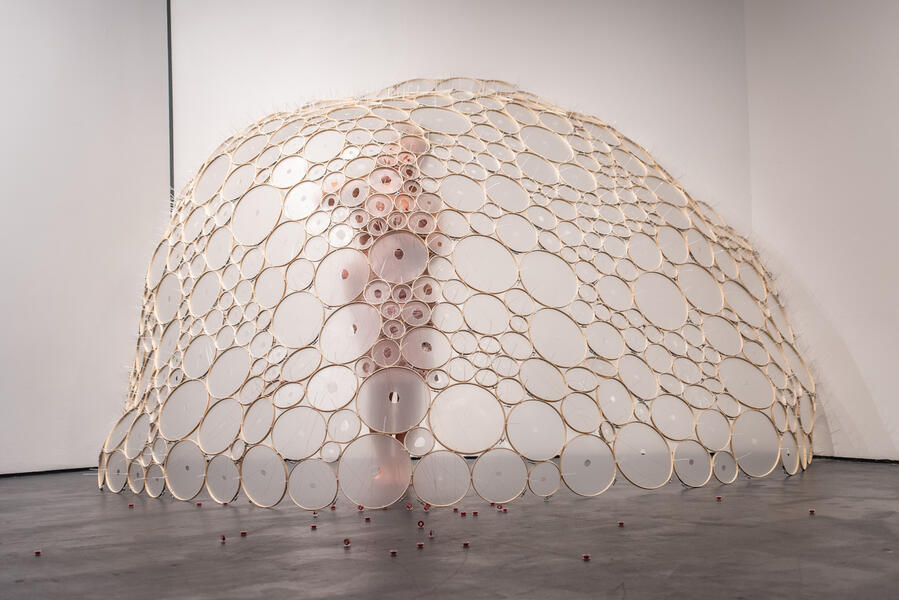 trace1-284 copy.jpegtrace (detail from live performance) water-soluble plastic, embroidery hoops, zip ties, water, glue, thread, fabric, bobbins
trace1-284 copy.jpegtrace (detail from live performance) water-soluble plastic, embroidery hoops, zip ties, water, glue, thread, fabric, bobbins -
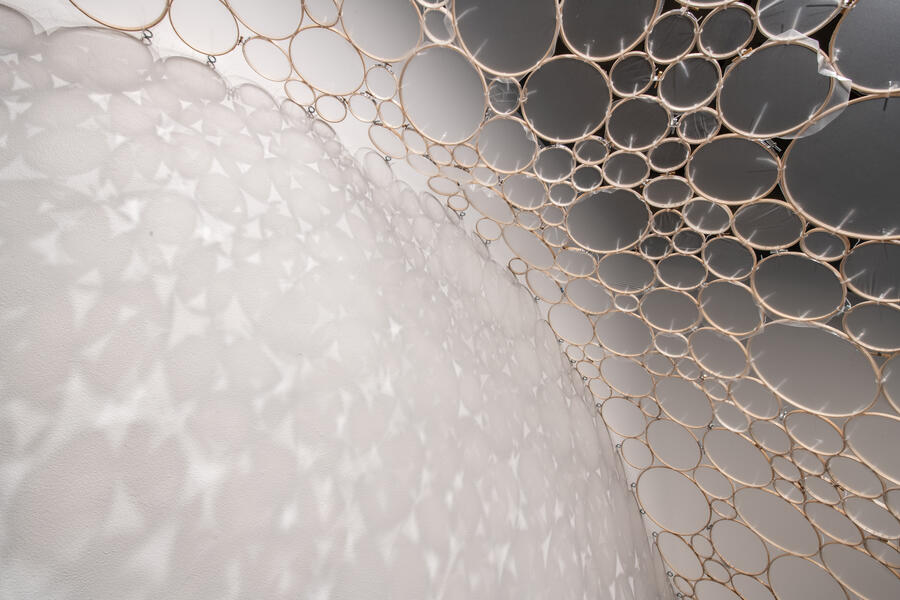 Denver_sept2019-18.jpgtrace (detail from live performance) water-soluble plastic, embroidery hoops, zip ties, water, glue, thread, fabric, bobbins
Denver_sept2019-18.jpgtrace (detail from live performance) water-soluble plastic, embroidery hoops, zip ties, water, glue, thread, fabric, bobbins -
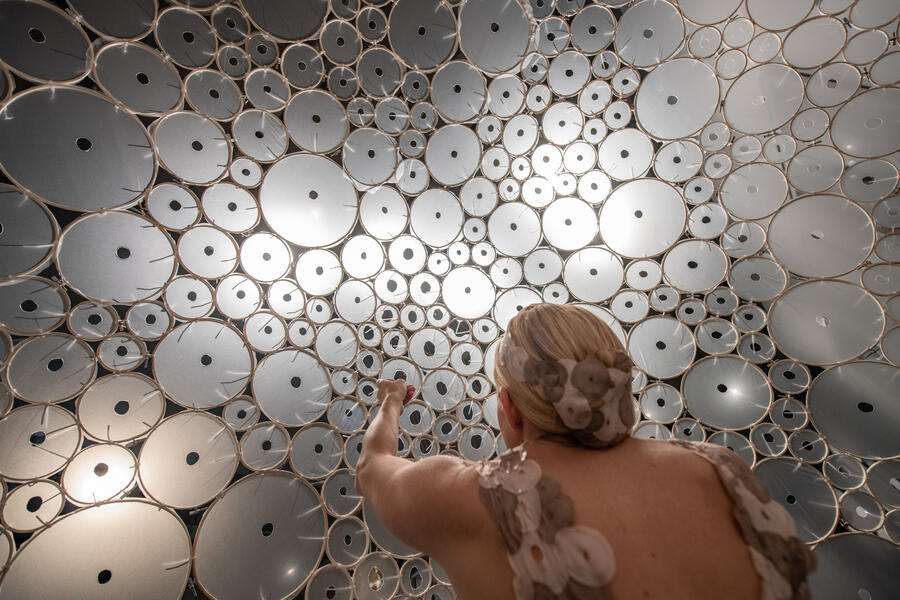 trace2-349 copy.jpegtrace (detail from live performance) water-soluble plastic, embroidery hoops, zip ties, water, glue, thread, fabric, bobbins
trace2-349 copy.jpegtrace (detail from live performance) water-soluble plastic, embroidery hoops, zip ties, water, glue, thread, fabric, bobbins -
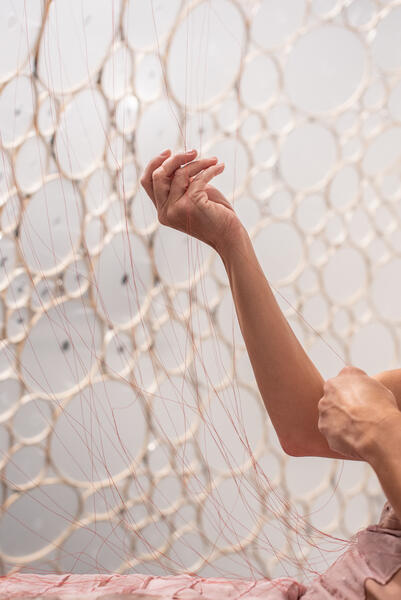 trace3-318 copy.jpegtrace (detail from live performance) water-soluble plastic, embroidery hoops, zip ties, water, glue, thread, fabric, bobbins
trace3-318 copy.jpegtrace (detail from live performance) water-soluble plastic, embroidery hoops, zip ties, water, glue, thread, fabric, bobbins -
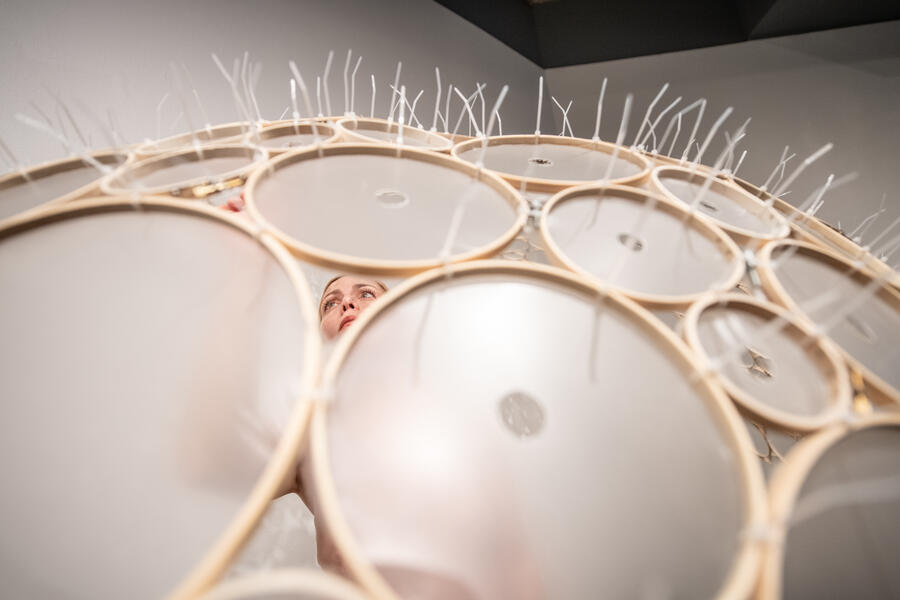 trace-176.jpgtrace (detail from live performance) water-soluble plastic, embroidery hoops, zip ties, water, glue, thread, fabric, bobbins
trace-176.jpgtrace (detail from live performance) water-soluble plastic, embroidery hoops, zip ties, water, glue, thread, fabric, bobbins -
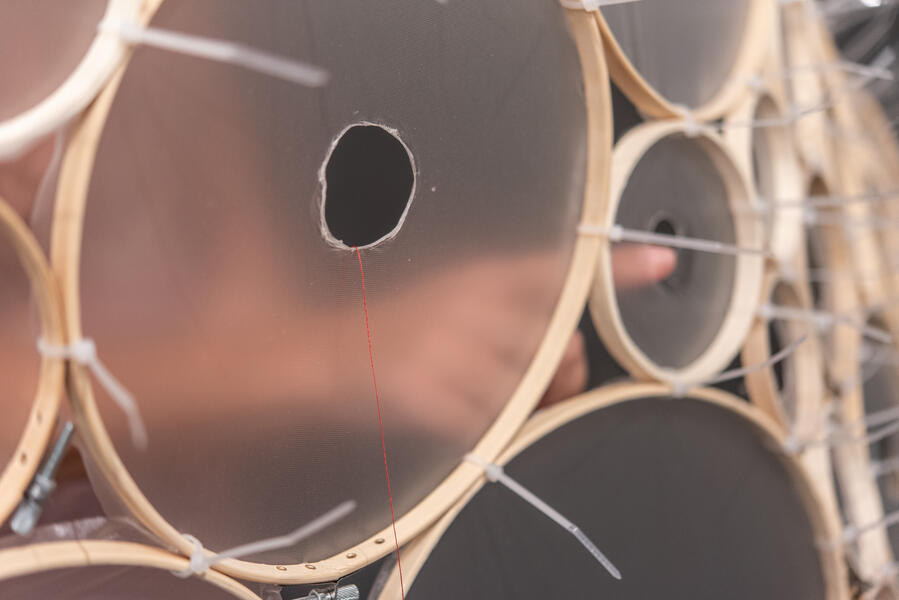 trace-264.jpgtrace (detail from live performance) water-soluble plastic, embroidery hoops, zip ties, water, glue, thread, fabric, bobbins
trace-264.jpgtrace (detail from live performance) water-soluble plastic, embroidery hoops, zip ties, water, glue, thread, fabric, bobbins -
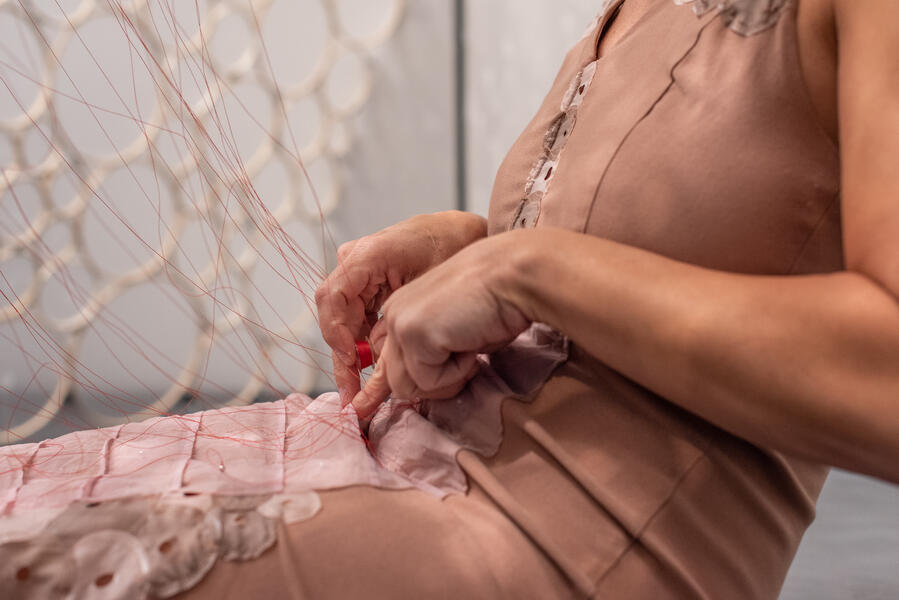 trace-316.jpgtrace (detail from live performance) water-soluble plastic, embroidery hoops, zip ties, water, glue, thread, fabric, bobbins
trace-316.jpgtrace (detail from live performance) water-soluble plastic, embroidery hoops, zip ties, water, glue, thread, fabric, bobbins -
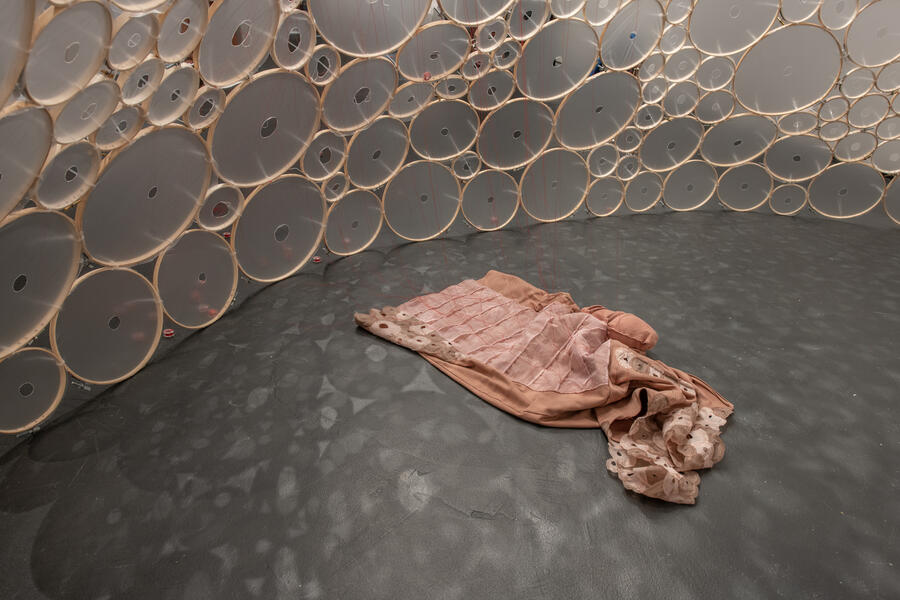 trace4-366 copy.jpegtrace (detail from live performance) water-soluble plastic, embroidery hoops, zip ties, water, glue, thread, fabric, bobbins
trace4-366 copy.jpegtrace (detail from live performance) water-soluble plastic, embroidery hoops, zip ties, water, glue, thread, fabric, bobbins -
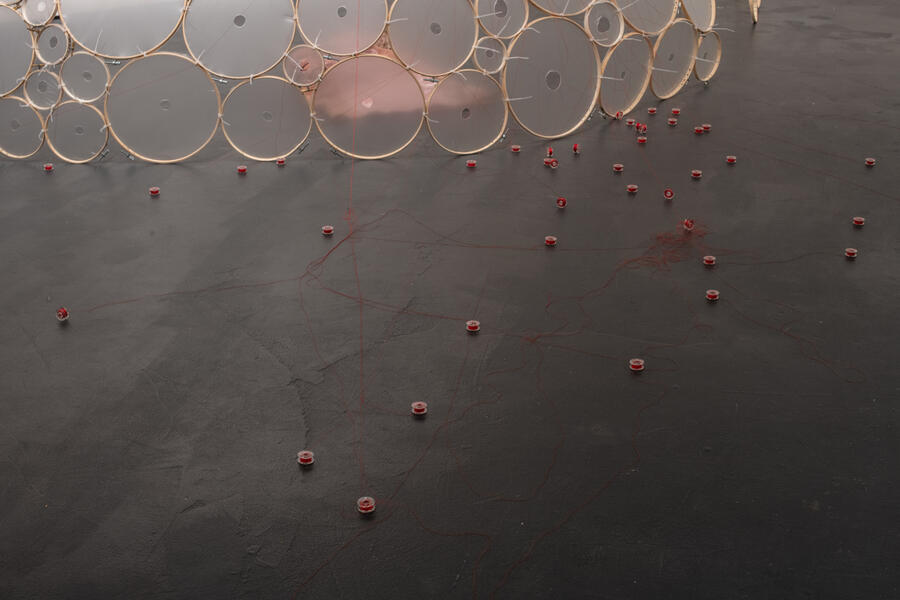 trace-371.jpgtrace (detail from live performance) water-soluble plastic, embroidery hoops, zip ties, water, glue, thread, fabric, bobbins
trace-371.jpgtrace (detail from live performance) water-soluble plastic, embroidery hoops, zip ties, water, glue, thread, fabric, bobbins
billow
A field of disposable surgical caps, stiffened with starch and supported by a monofilament net, filled the Corcoran's grand atrium. Delineated by skylights in the floor, the field referenced a floating swimming pool and revealed a perch-like skirt structure. I began the performance on the perch by erasing a water-soluble ink drawing and then retreated below the surface. From beneath the field I sprayed water into the air, allowing moisture to wilt caps surrounding the perch. As I worked I tugged on the net and manipulated the surface, causing the whole area to tremble. Small gestures were amplified across a great distance, like a spider activating its web.
-
 billow4000+ surgical caps were starched and placed on the surface of a monofilament net, supported by a steel armature. In the beginning of the performance I erased a water-soluble ink drawing on fabric. I then retreated below the surface and sprayed water into the air in order to wilt the surrounding field.
billow4000+ surgical caps were starched and placed on the surface of a monofilament net, supported by a steel armature. In the beginning of the performance I erased a water-soluble ink drawing on fabric. I then retreated below the surface and sprayed water into the air in order to wilt the surrounding field. -
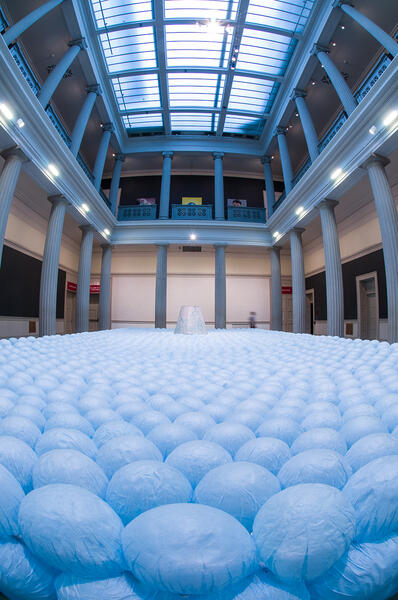 billow4000+ surgical caps were starched and placed on the surface of a monofilament net, supported by a steel armature. In the beginning of the performance I erased a water-soluble ink drawing on fabric. I then retreated below the surface and sprayed water into the air in order to wilt the surrounding field.
billow4000+ surgical caps were starched and placed on the surface of a monofilament net, supported by a steel armature. In the beginning of the performance I erased a water-soluble ink drawing on fabric. I then retreated below the surface and sprayed water into the air in order to wilt the surrounding field. -
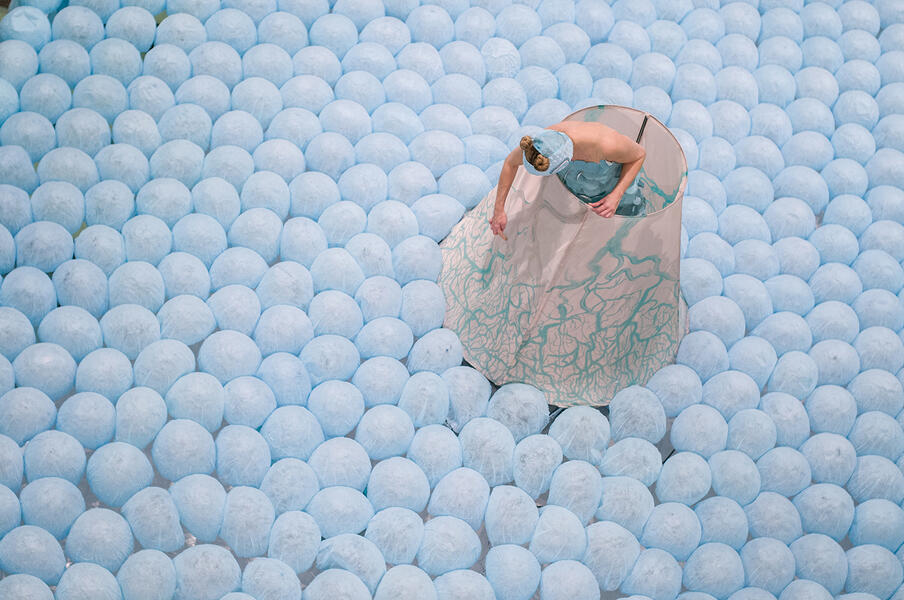 billow4000+ surgical caps were starched and placed on the surface of a monofilament net, supported by a steel armature. In the beginning of the performance I erased a water-soluble ink drawing on fabric. I then retreated below the surface and sprayed water into the air in order to wilt the surrounding field.
billow4000+ surgical caps were starched and placed on the surface of a monofilament net, supported by a steel armature. In the beginning of the performance I erased a water-soluble ink drawing on fabric. I then retreated below the surface and sprayed water into the air in order to wilt the surrounding field. -
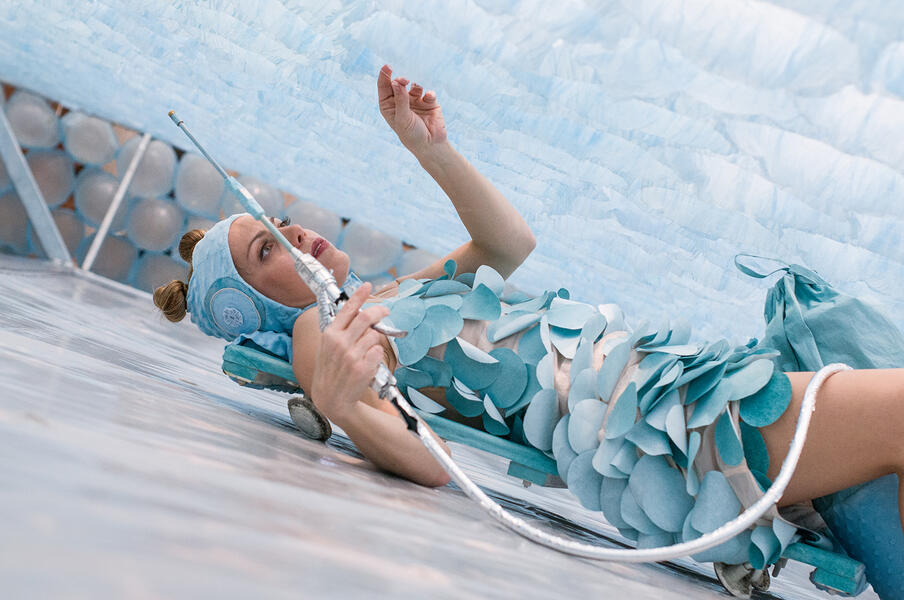 billow4000+ surgical caps were starched and placed on the surface of a monofilament net, supported by a steel armature. In the beginning of the performance I erased a water-soluble ink drawing on fabric. I then retreated below the surface and sprayed water into the air in order to wilt the surrounding field.
billow4000+ surgical caps were starched and placed on the surface of a monofilament net, supported by a steel armature. In the beginning of the performance I erased a water-soluble ink drawing on fabric. I then retreated below the surface and sprayed water into the air in order to wilt the surrounding field. -
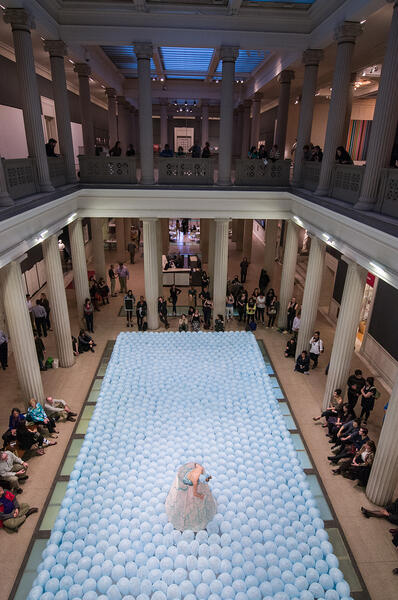 billow4000+ surgical caps were starched and placed on the surface of a monofilament net, supported by a steel armature. In the beginning of the performance I erased a water-soluble ink drawing on fabric. I then retreated below the surface and sprayed water into the air in order to wilt the surrounding field.
billow4000+ surgical caps were starched and placed on the surface of a monofilament net, supported by a steel armature. In the beginning of the performance I erased a water-soluble ink drawing on fabric. I then retreated below the surface and sprayed water into the air in order to wilt the surrounding field. -
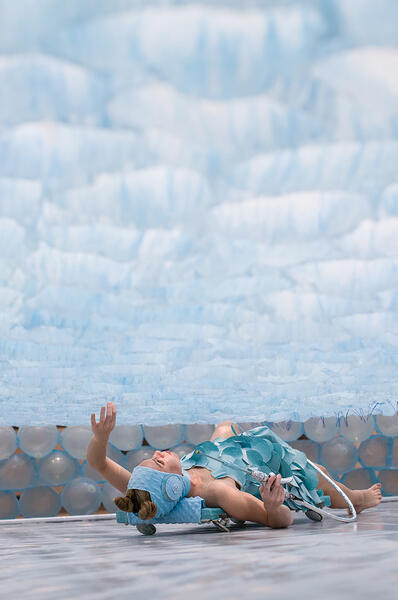 billow4000+ surgical caps were starched and placed on the surface of a monofilament net, supported by a steel armature. In the beginning of the performance I erased a water-soluble ink drawing on fabric. I then retreated below the surface and sprayed water into the air in order to wilt the surrounding field.
billow4000+ surgical caps were starched and placed on the surface of a monofilament net, supported by a steel armature. In the beginning of the performance I erased a water-soluble ink drawing on fabric. I then retreated below the surface and sprayed water into the air in order to wilt the surrounding field. -
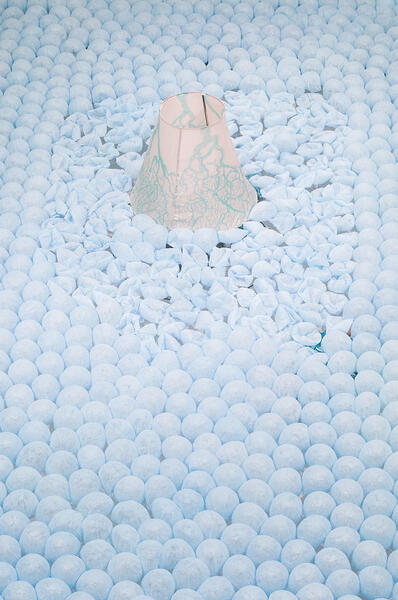 billow4000+ surgical caps were starched and placed on the surface of a monofilament net, supported by a steel armature. In the beginning of the performance I erased a water-soluble ink drawing on fabric. I then retreated below the surface and sprayed water into the air in order to wilt the surrounding field.
billow4000+ surgical caps were starched and placed on the surface of a monofilament net, supported by a steel armature. In the beginning of the performance I erased a water-soluble ink drawing on fabric. I then retreated below the surface and sprayed water into the air in order to wilt the surrounding field. -
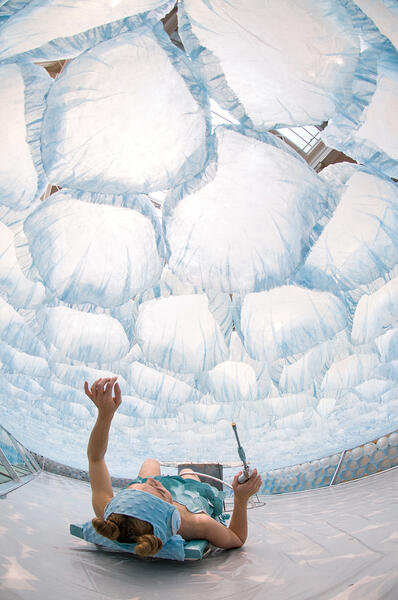 billow
billow -
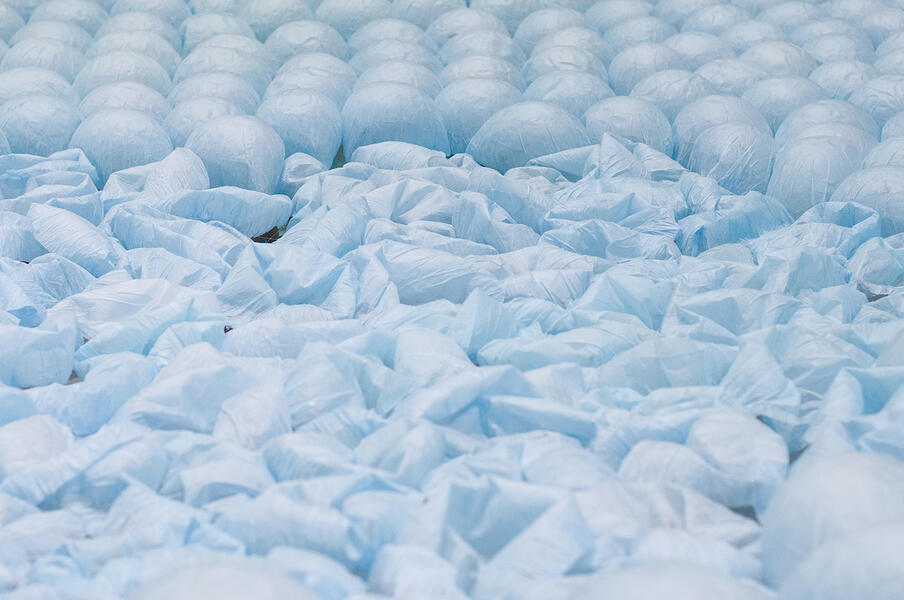 billow4000+ surgical caps were starched and placed on the surface of a monofilament net, supported by a steel armature. In the beginning of the performance I erased a water-soluble ink drawing on fabric. I then retreated below the surface and sprayed water into the air in order to wilt the surrounding field.
billow4000+ surgical caps were starched and placed on the surface of a monofilament net, supported by a steel armature. In the beginning of the performance I erased a water-soluble ink drawing on fabric. I then retreated below the surface and sprayed water into the air in order to wilt the surrounding field. -
billow documentation
mend
With a wet fingertip I traced the center of each water-soluble membrane (at my eye level) until the center melted away. When the horizon line of circles was completely activated, I began to sew. Taking two bobbins from each wall pocket, I found the corresponding opening in the sculpture and forced both bobbins through to the other side. I crawled through the opening on the floor in order to retrieve one bobbin. The bobbin was sent back through the adjacent hole, thus completing one stitch. Each passage through the opening was recorded by markers that traced my trajectory. Over time the marks grew more layered and visible. The thread became tangled despite my orderly task. Through repeated gesture, my progress impeded my progress, like a spider getting caught in its own web.
Artist Statement:
Insects encase themselves for protection, to create a place where metamorphosis can occur. Utilizing their own secretions, they produce raw materials from which they build. For me, the insect is a metaphor for human behavior. Like insects we are defined by the physical inevitability of our cycles of growth and reproduction, as well as our social need for physical labor.
I have explored these parallels by constructing sculptural costumes that encase my body and resemble cocoons, and then further developed these structures through performance. Exploring the concepts of change and transformation I encase myself in a structure that provides both a covering for my body, as well as a site for an activity. My motion is restricted, and I engage in a repeated action that involves the movement of a material from one part of the structure to another. This process alludes to cannibalism, and also imparts ideas of self-sufficiency implicit in such a closed system.
In one work, entitled Loop, I crocheted a cocoon of tubes to envelop my body like a circulatory system. I sucked on one end of the continuous circuit, drawing fluid from the other end of the long tube, anchored in a pouch on my belly. In another, Seep, my dress extended from my body to become a landscape, its perimeter far beyond my reach. I dipped a 12-foot ladle into a trough of water to slowly dissolve the dress from the hem to the bodice.
In these and in all of my works, the elements are constructed through a laborious process of weaving, braiding, or sewing. They are then activated in performance through a similar process of methodical alteration. I share the space intimately with my audience and communicate not only through sight and movement, but also sound and touch. Utilizing temporal materials such as gelatins, fluids, or water-soluble plastics, I speak to the notion of time and change. These are repetitive actions that build and transform a work, like a spider, strand by strand, spinning a web, or a wasp, layer by layer, building a nest.
-
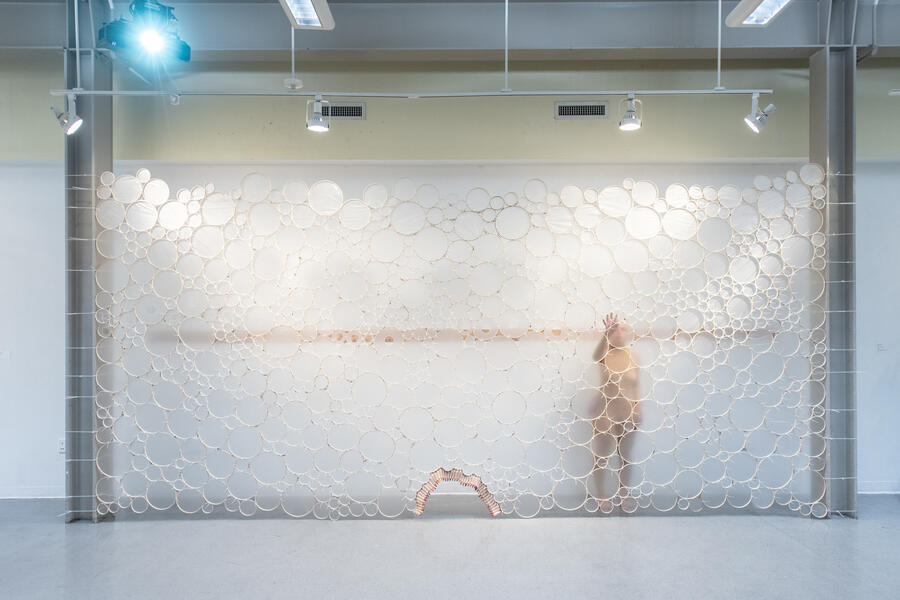 mend_2019-86.jpgPerformance detail from "mend". With a wet fingertip I traced the center of each water-soluble membrane (at my eye level) until the center melted away. When the horizon line of circles was completely activated, I began to sew. Taking two bobbins from each wall pocket, I found the corresponding opening in the sculpture and forced both bobbins through to the other side. I crawled through the opening on the floor in order to retrieve one bobbin. The bobbin was sent back through the adjacent hole, thus completing one stitch. Each passage through the opening was recorded by markers that traced my trajectory. Over time the marks grew more layered and visible. The thread became tangled despite my orderly task. Through repeated gesture, my progress impeded my progress, like a spider getting caught in its own web.
mend_2019-86.jpgPerformance detail from "mend". With a wet fingertip I traced the center of each water-soluble membrane (at my eye level) until the center melted away. When the horizon line of circles was completely activated, I began to sew. Taking two bobbins from each wall pocket, I found the corresponding opening in the sculpture and forced both bobbins through to the other side. I crawled through the opening on the floor in order to retrieve one bobbin. The bobbin was sent back through the adjacent hole, thus completing one stitch. Each passage through the opening was recorded by markers that traced my trajectory. Over time the marks grew more layered and visible. The thread became tangled despite my orderly task. Through repeated gesture, my progress impeded my progress, like a spider getting caught in its own web. -
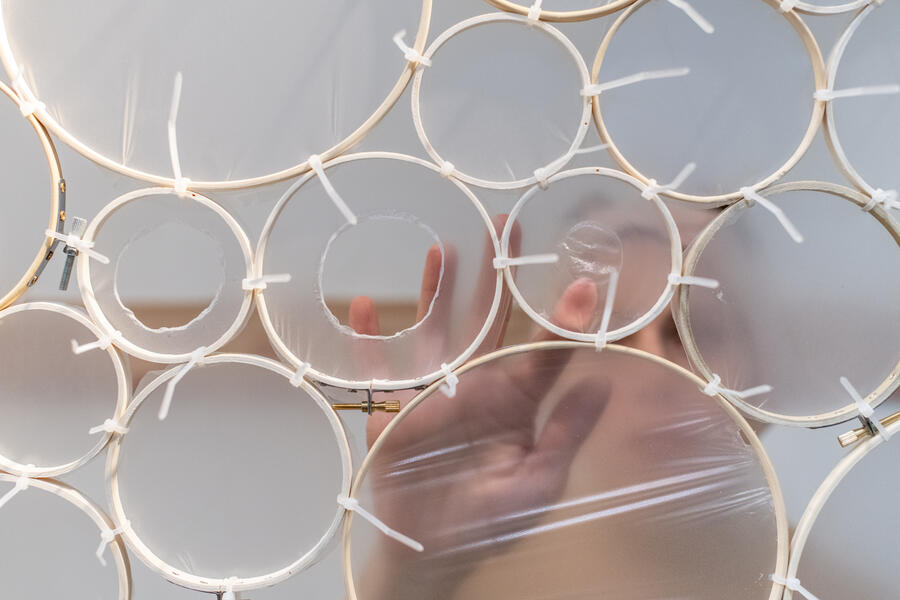 mend(detail).jpgmend (detail from live performance) water-soluble plastic, embroidery hoops, zip ties, fabric, thread, bobbins, glue, magnets, markers
mend(detail).jpgmend (detail from live performance) water-soluble plastic, embroidery hoops, zip ties, fabric, thread, bobbins, glue, magnets, markers -
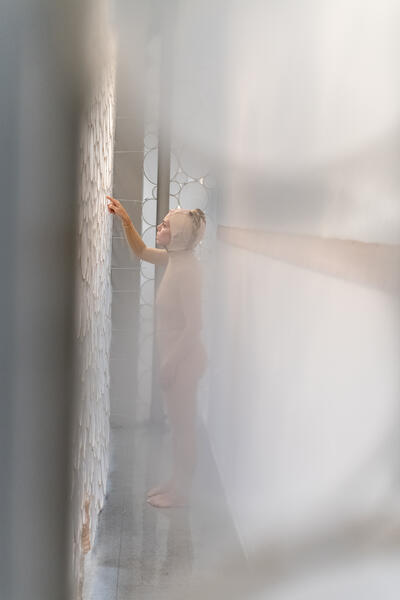 mend_2019-41.jpgmend (detail from live performance) water-soluble plastic, embroidery hoops, zip ties, fabric, thread, bobbins, glue, magnets, markers
mend_2019-41.jpgmend (detail from live performance) water-soluble plastic, embroidery hoops, zip ties, fabric, thread, bobbins, glue, magnets, markers -
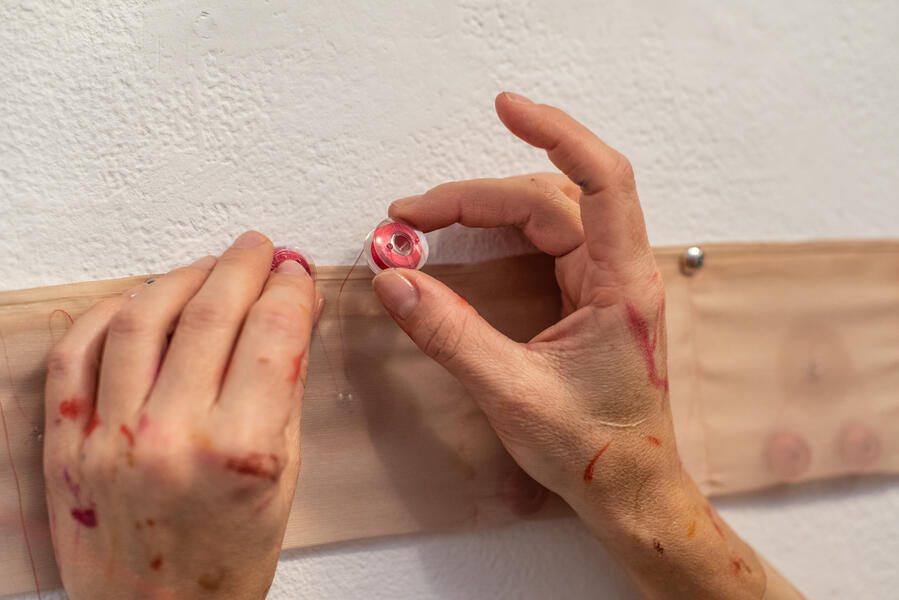 mend_2019-405.jpgmend (detail from live performance) water-soluble plastic, embroidery hoops, zip ties, fabric, thread, bobbins, glue, magnets, markers
mend_2019-405.jpgmend (detail from live performance) water-soluble plastic, embroidery hoops, zip ties, fabric, thread, bobbins, glue, magnets, markers -
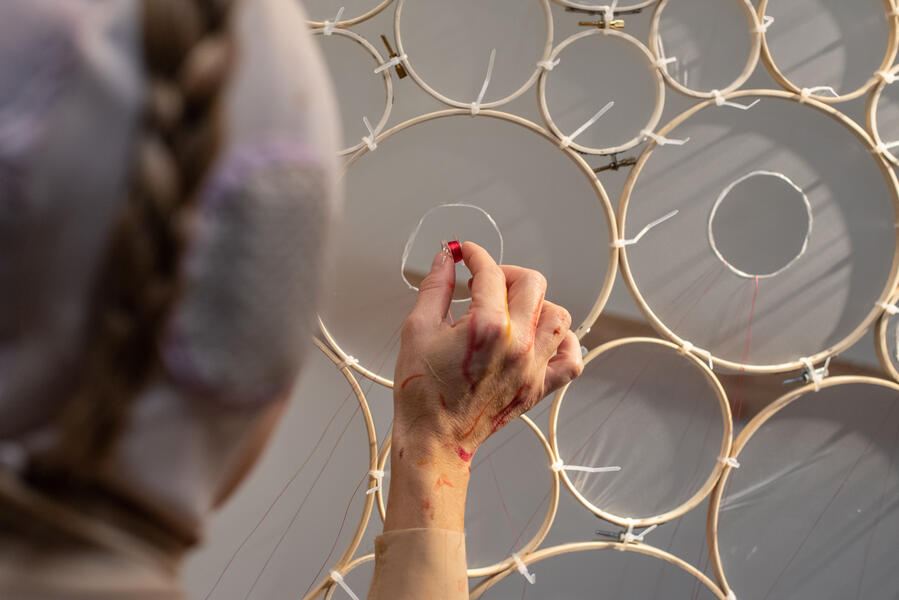 mend_2019-358.jpgmend (detail from live performance) water-soluble plastic, embroidery hoops, zip ties, fabric, thread, bobbins, glue, magnets, markers
mend_2019-358.jpgmend (detail from live performance) water-soluble plastic, embroidery hoops, zip ties, fabric, thread, bobbins, glue, magnets, markers -
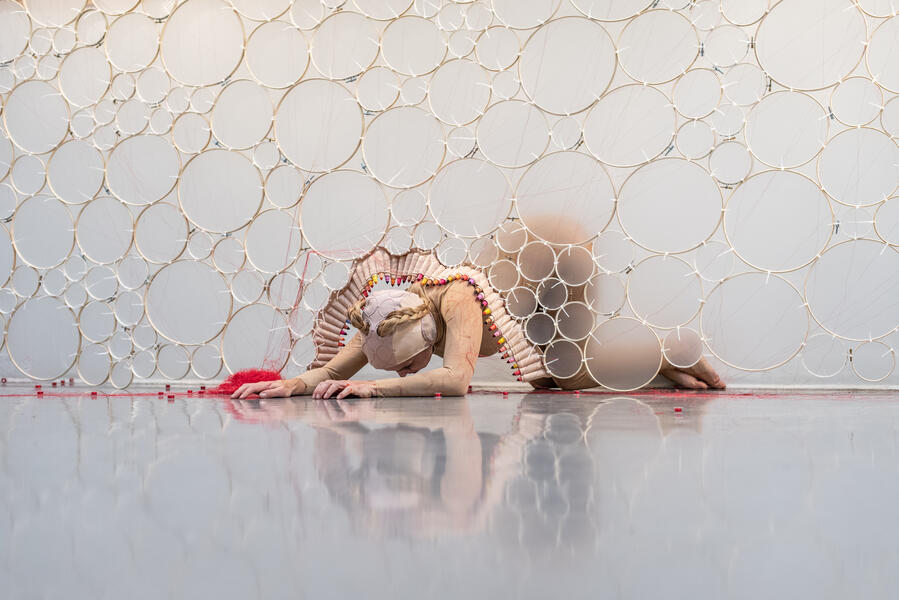 mend_2019-392.jpgmend (detail from live performance) water-soluble plastic, embroidery hoops, zip ties, fabric, thread, bobbins, glue, magnets, markers
mend_2019-392.jpgmend (detail from live performance) water-soluble plastic, embroidery hoops, zip ties, fabric, thread, bobbins, glue, magnets, markers -
mend_1367.JPEGmend (detail from live performance) water-soluble plastic, embroidery hoops, zip ties, fabric, thread, bobbins, glue, magnets, markers
-
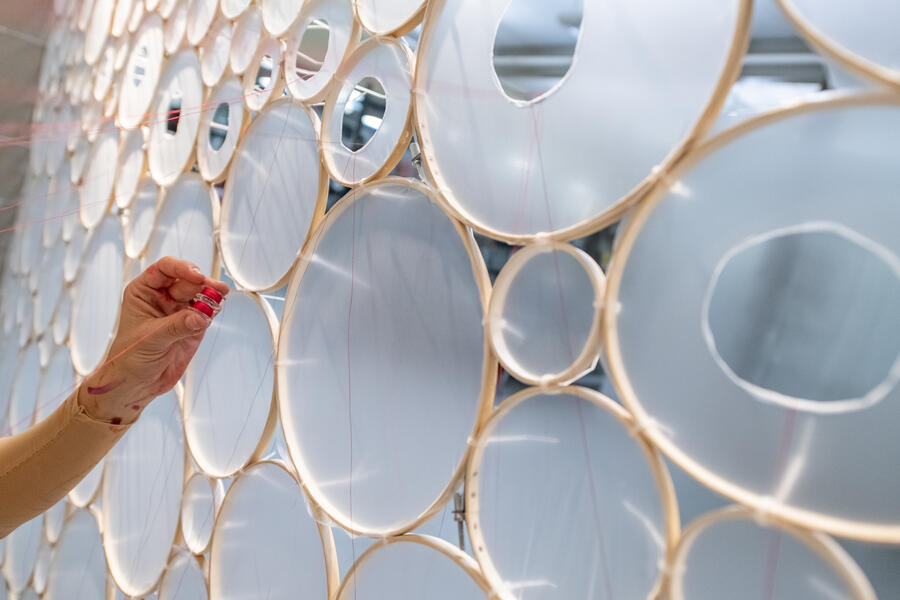 mend_2019-399.jpgmend (detail from live performance) water-soluble plastic, embroidery hoops, zip ties, fabric, thread, bobbins, glue, magnets, markers
mend_2019-399.jpgmend (detail from live performance) water-soluble plastic, embroidery hoops, zip ties, fabric, thread, bobbins, glue, magnets, markers -
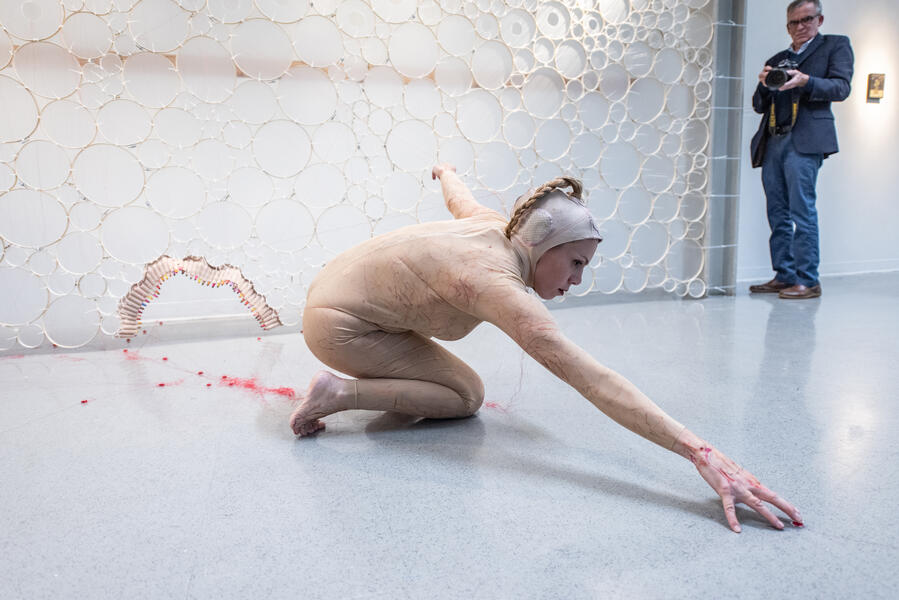 mend_2019-260.jpgmend (detail from live performance) water-soluble plastic, embroidery hoops, zip ties, fabric, thread, bobbins, glue, magnets, markers
mend_2019-260.jpgmend (detail from live performance) water-soluble plastic, embroidery hoops, zip ties, fabric, thread, bobbins, glue, magnets, markers -
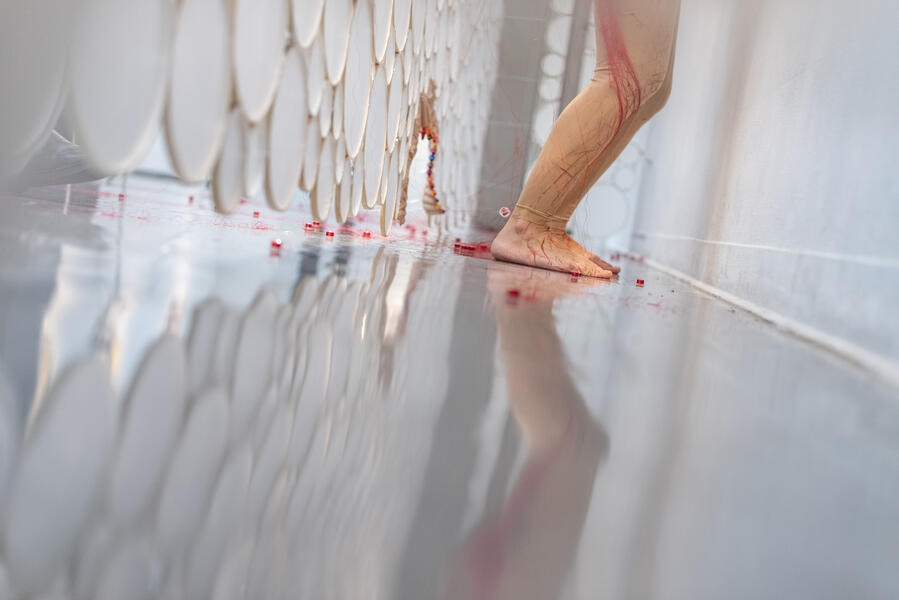 Mica_2019-308.jpg
Mica_2019-308.jpg
murmuration
Standing amidst a field of yellow construction mesh cylinders I unraveled a crocheted tubing structure that hung from the ceiling. A slight tug, a pull, allowed me to unfurl a seemingly unending line of tube that was systematically joined to components in the landscape. Stacking individual cylinders vertically, I used the line of tubing to stitch the forms together, until each spindly tower nearly toppled. I lay each tower down at my feet, slowly constructing a drawing reminiscent of a crop circle.
The residue of the performance remained in the gallery for the duration of the exhibition.
Statement about murmuration:
A swarm of starlings is a living cloud. Twitching and winking, individual divers dart and turn in perfect precision forming first a swell and then a funnel. In these moments individual solids move together to reference liquids. Pouring and flowing, a wave becomes a tail that threads itself back into the pulsating body.
Starlings careen past one another but never collide. Their trajectory is as measured as threads finding purchase through the warp of a loom.
Like birds, we are connected by proxy to those beside us. Sensing tension, joy, or strain, we adjust our course. How fluid shifts can be, devoid of reason, when there is only response.
Bees, too, travel en masse. Leaving one home in search of another, they form a shadowy apparition, buzzing and trembling, like grey lungs taking measured breaths.
What triggers these spontaneous choreographies? Is it the wind ruffling feathers, a restless queen, or a heavy foot on the pedal of a sewing machine? One nearly imperceptible motion can launch a dance, causing upper and lower bobbins to unspool and reunite in a singular interlocking stitch.
I am interested in occurrences in which nature, or materials, defy logic, announcing themselves as simultaneously humble and majestic. Humans attempt to achieve similar perfection, only to fall short. There is beauty in our clumsy attempts, in our determination and hope, and in the acquiescence, that despite our shortcomings, we will continue to labor in perpetuity.
-
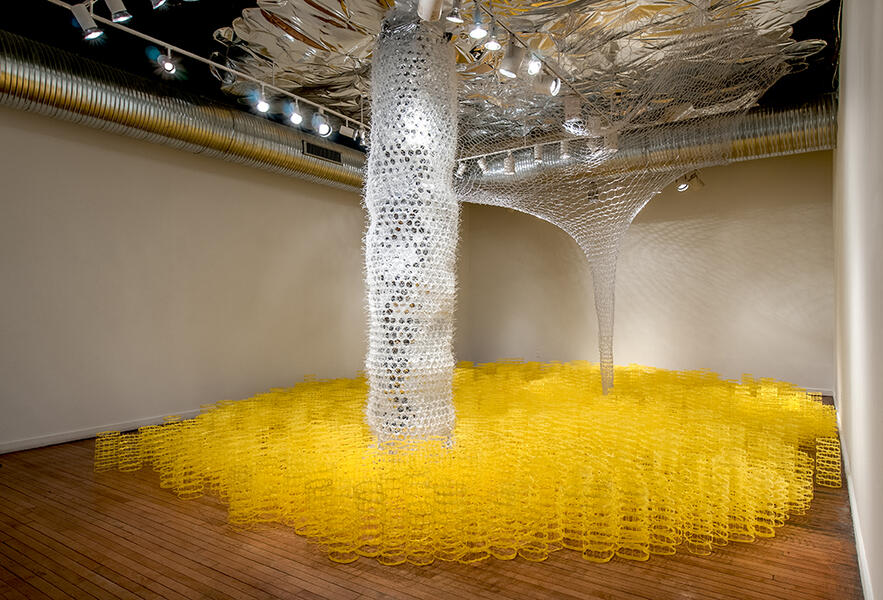 murmuration.jpgmurmuration (detail) crocheted surgical tubing, construction mesh, mylar, zip ties, plastic, fabric
murmuration.jpgmurmuration (detail) crocheted surgical tubing, construction mesh, mylar, zip ties, plastic, fabric -
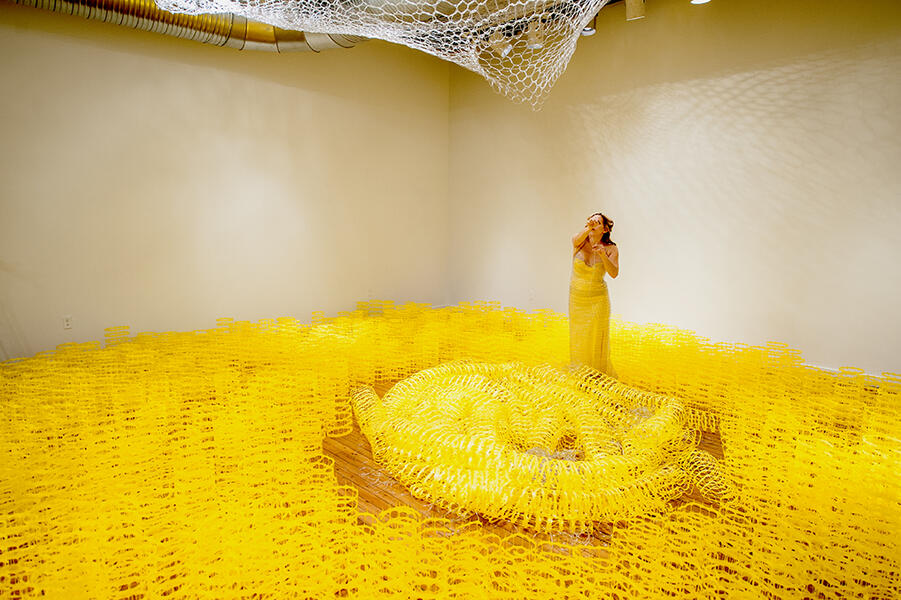 murmurationdetailone.jpgmurmuration (performance detail) crocheted surgical tubing, construction mesh, mylar, zip ties, plastic, fabric
murmurationdetailone.jpgmurmuration (performance detail) crocheted surgical tubing, construction mesh, mylar, zip ties, plastic, fabric -
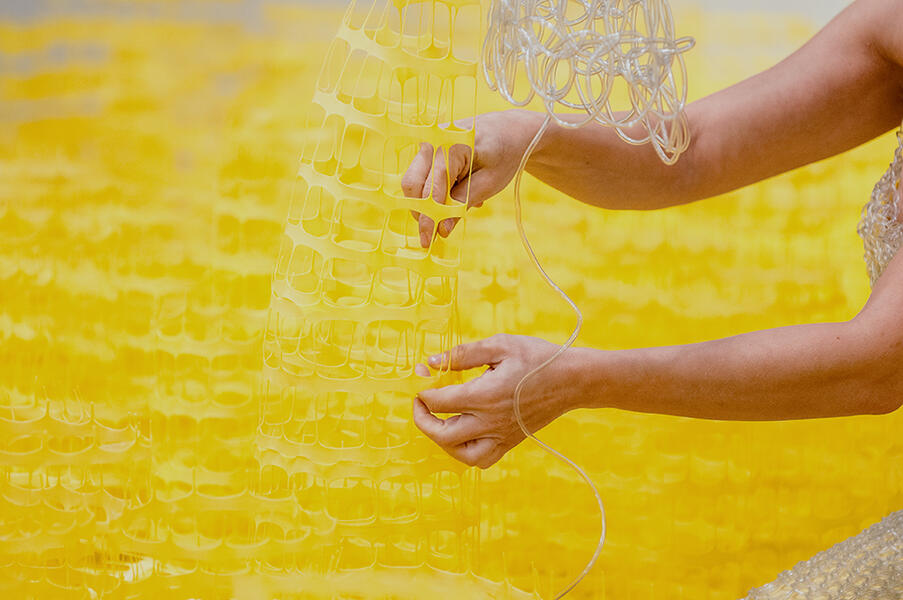 murmurationdetailtwo.jpgmurmuration (performance detail) crocheted surgical tubing, construction mesh, mylar, zip ties, plastic, fabric
murmurationdetailtwo.jpgmurmuration (performance detail) crocheted surgical tubing, construction mesh, mylar, zip ties, plastic, fabric -
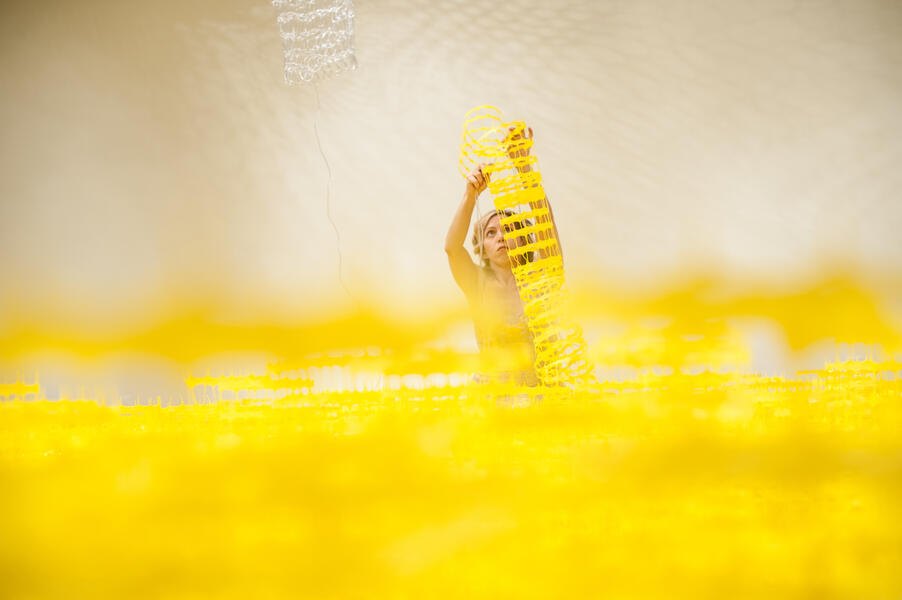 murmuration-181.jpgmurmuration (performance detail) crocheted surgical tubing, construction mesh, mylar, zip ties, plastic, fabric
murmuration-181.jpgmurmuration (performance detail) crocheted surgical tubing, construction mesh, mylar, zip ties, plastic, fabric -
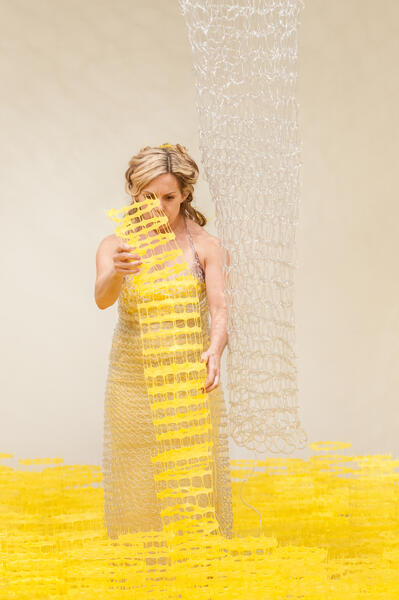 murmuration-66.jpgmurmuration (performance detail) crocheted surgical tubing, construction mesh, mylar, zip ties, plastic, fabric
murmuration-66.jpgmurmuration (performance detail) crocheted surgical tubing, construction mesh, mylar, zip ties, plastic, fabric -
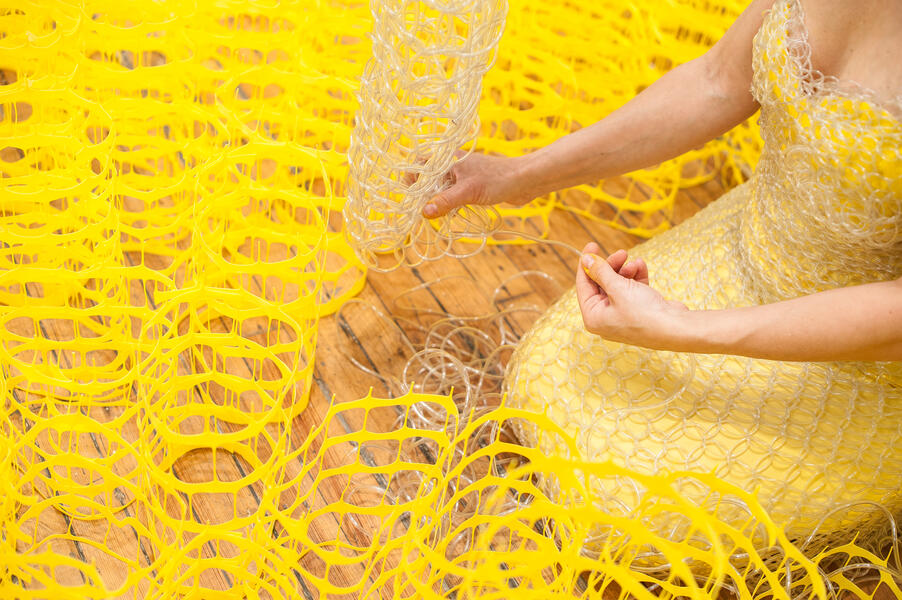 04murmurationdetail.jpgmurmuration (performance detail) crocheted surgical tubing, construction mesh, mylar, zip ties, plastic, fabric
04murmurationdetail.jpgmurmuration (performance detail) crocheted surgical tubing, construction mesh, mylar, zip ties, plastic, fabric -
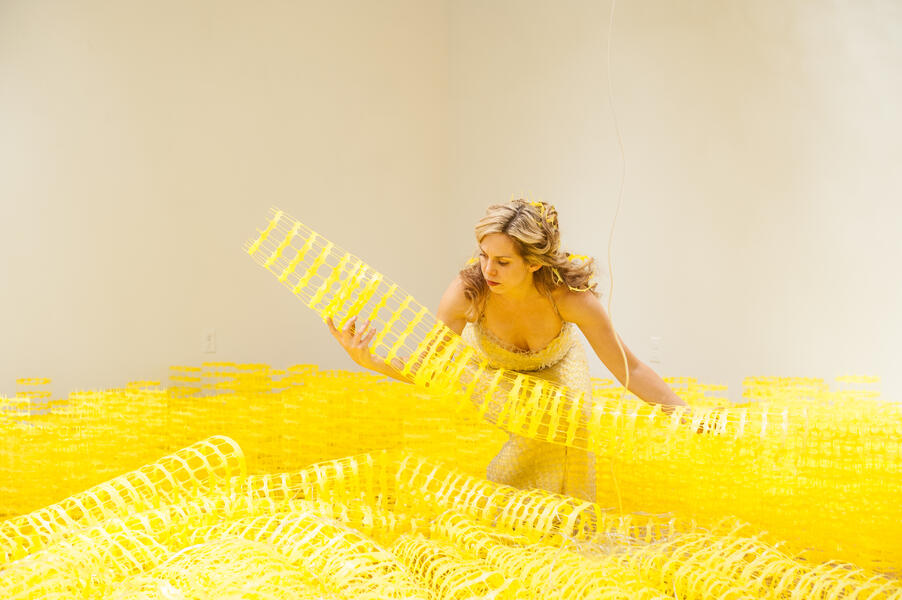 murmuration-420.jpgmurmuration (performance detail) crocheted surgical tubing, construction mesh, mylar, zip ties, plastic, fabric
murmuration-420.jpgmurmuration (performance detail) crocheted surgical tubing, construction mesh, mylar, zip ties, plastic, fabric -
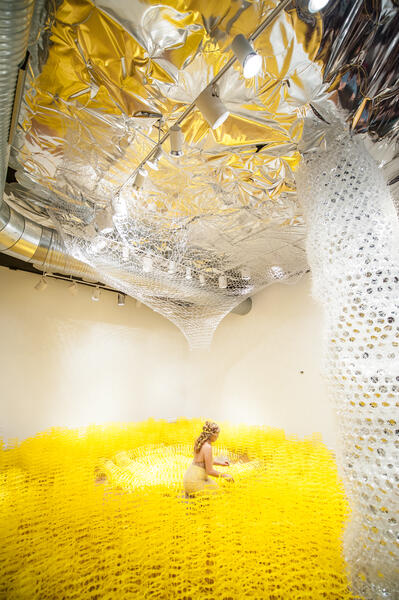 murmuration-270.jpgmurmuration (performance detail) crocheted surgical tubing, construction mesh, mylar, zip ties, plastic, fabric
murmuration-270.jpgmurmuration (performance detail) crocheted surgical tubing, construction mesh, mylar, zip ties, plastic, fabric -
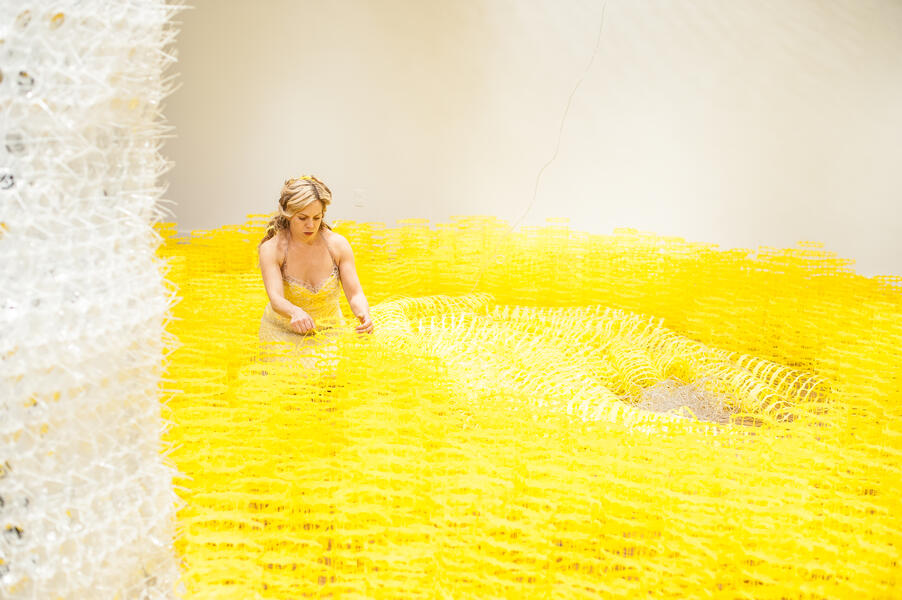 murmuration-253.jpgmurmuration (performance detail) crocheted surgical tubing, construction mesh, mylar, zip ties, plastic, fabric
murmuration-253.jpgmurmuration (performance detail) crocheted surgical tubing, construction mesh, mylar, zip ties, plastic, fabric
periphery
Five domes (constructed from clear cups and cable ties) inhabited a corner of the gallery at the Baltimore Museum of Art. Each dome sat upon a mirrored mylar footprint. In the viewer's periphery, mylar reflections created the illusion of spheres that dipped below the floor.
From a perch in the largest dome I stood crocheting fishing line for the duration of the opening reception.
-
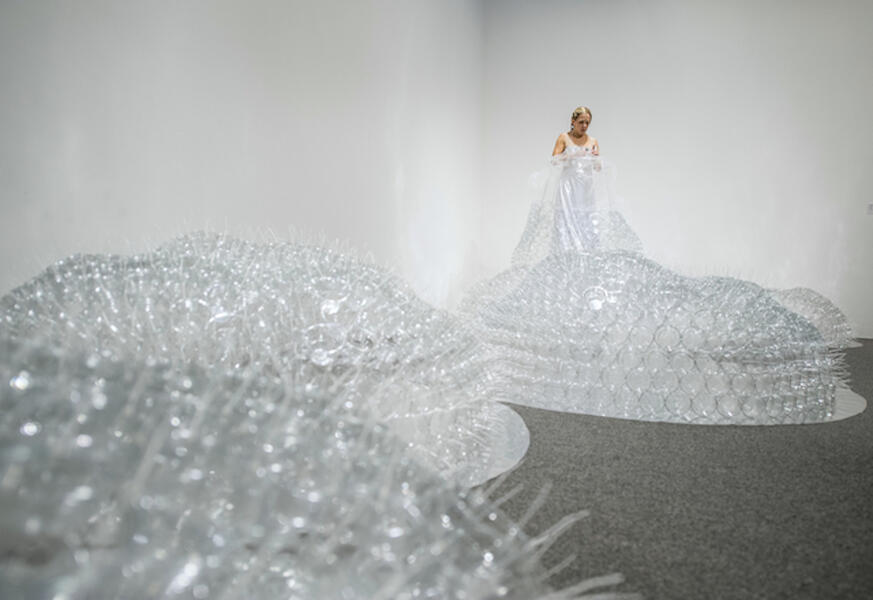 peripheryplastic cups, cable ties, mylar, crocheted fishing line
peripheryplastic cups, cable ties, mylar, crocheted fishing line -
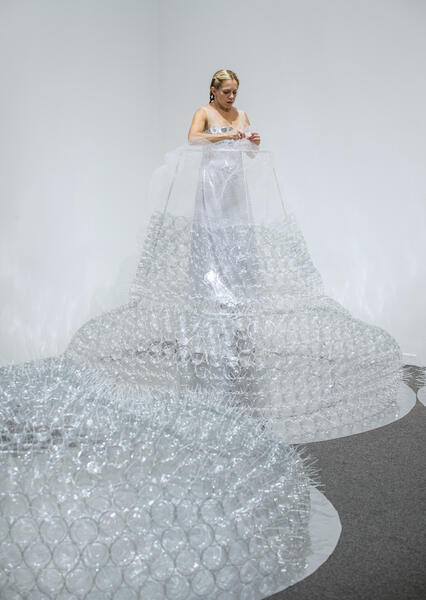 peripheryplastic cups, cable ties, mylar, crocheted fishing line
peripheryplastic cups, cable ties, mylar, crocheted fishing line -
 peripheryplastic cups, cable ties, mylar, crocheted fishing line
peripheryplastic cups, cable ties, mylar, crocheted fishing line -
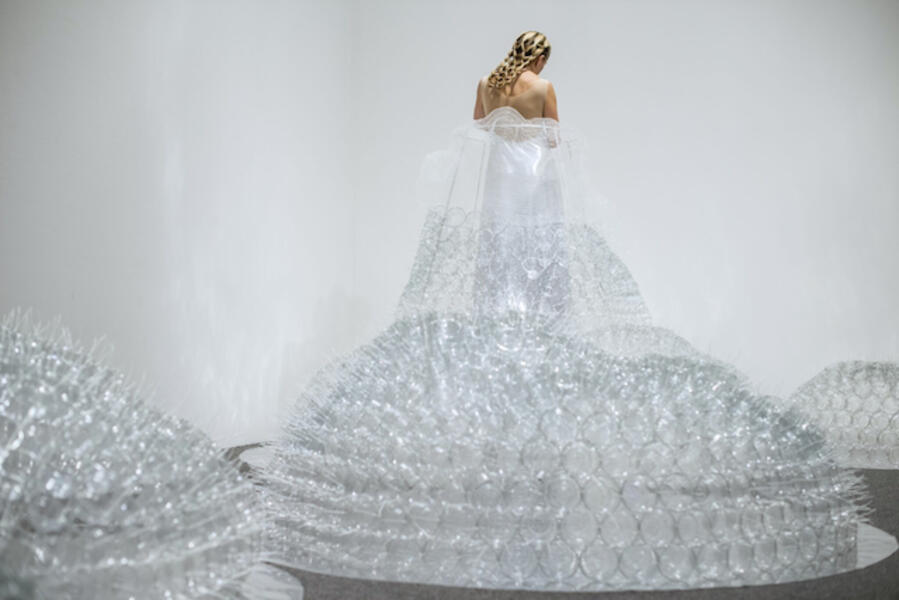 peripheryplastic cups, cable ties, mylar, crocheted fishing line
peripheryplastic cups, cable ties, mylar, crocheted fishing line -
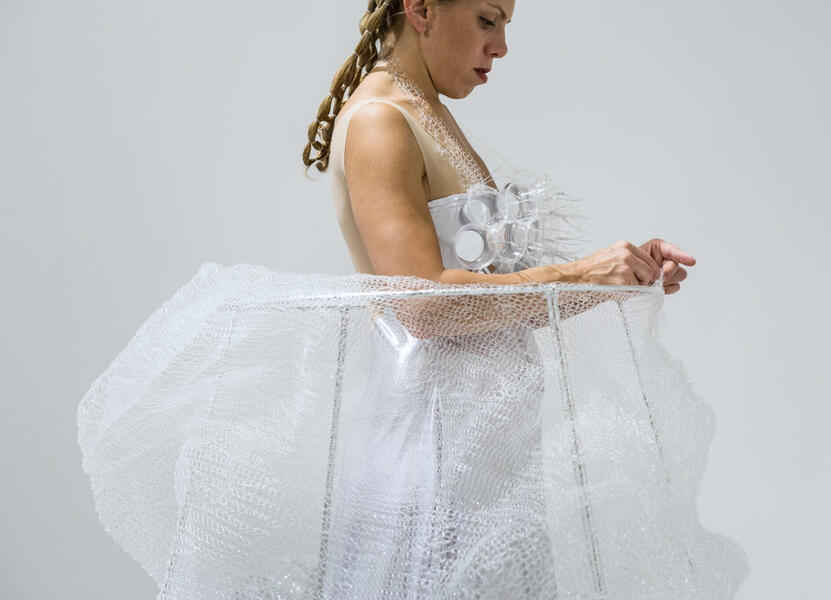 peripheryplastic cups, cable ties, mylar, crocheted fishing line
peripheryplastic cups, cable ties, mylar, crocheted fishing line -
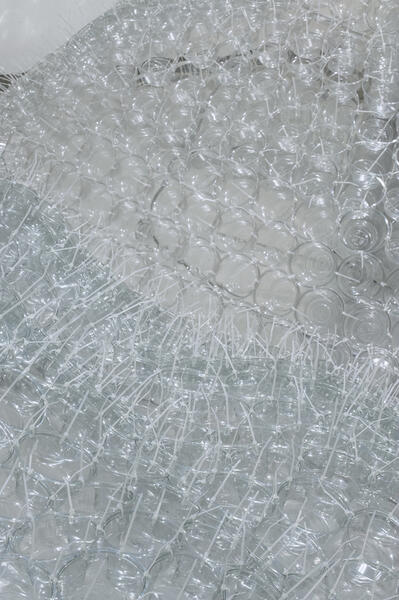 peripheryplastic cups, cable ties, mylar, crocheted fishing line
peripheryplastic cups, cable ties, mylar, crocheted fishing line -
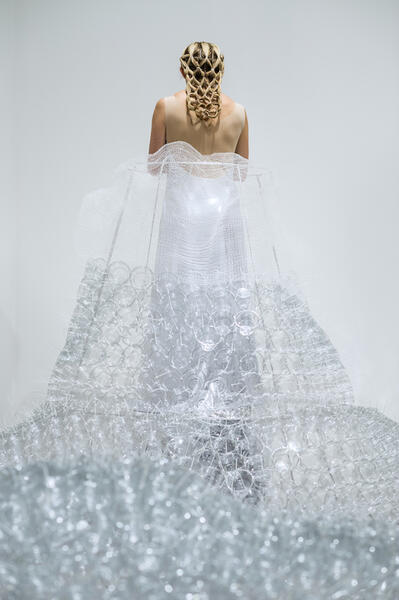 peripheryplastic cups, cable ties, mylar, crocheted fishing line
peripheryplastic cups, cable ties, mylar, crocheted fishing line -
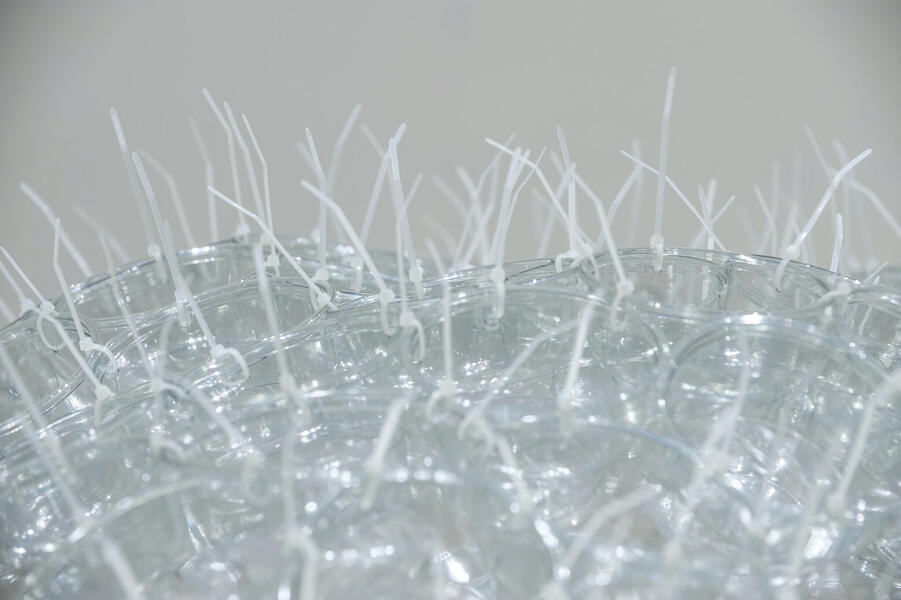 peripheryplastic cups, cable ties, mylar, crocheted fishing line
peripheryplastic cups, cable ties, mylar, crocheted fishing line -
periphery documentationsculptural installation and performance at the Baltimore Museum of Art, Baltimore, MD Five domes (constructed from clear cups and cable ties) inhabited a corner of the gallery at the Baltimore Museum of Art. Each dome sat upon a mirrored mylar footprint. In the viewer's periphery, mylar reflections created the illusion of spheres that dipped below the floor. From a perch in the largest dome I stood crocheting fishing line for the duration of the opening reception.
bouyant
-
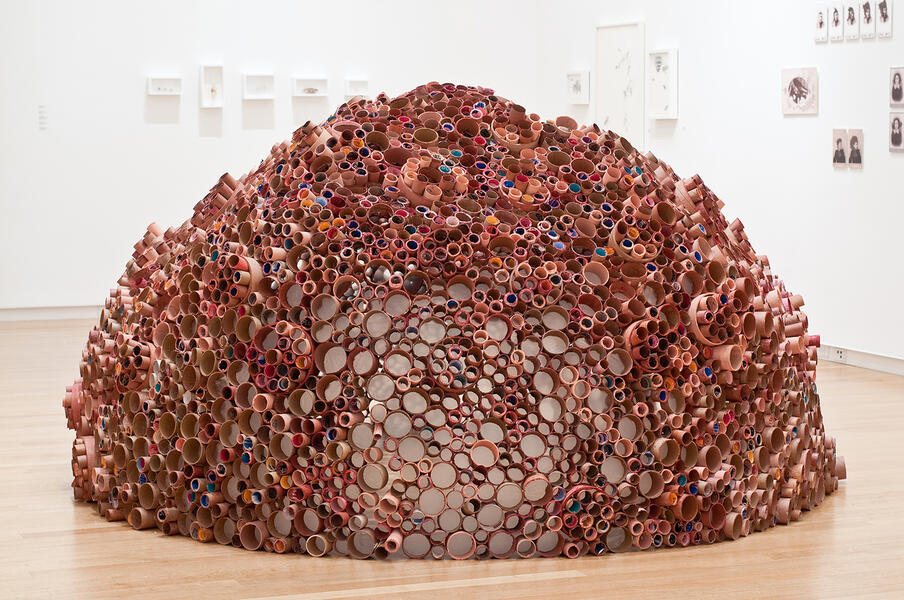 bouyantcardboard tubes, water-soluble plastic, water, paper, paint, glue, latex
bouyantcardboard tubes, water-soluble plastic, water, paper, paint, glue, latex -
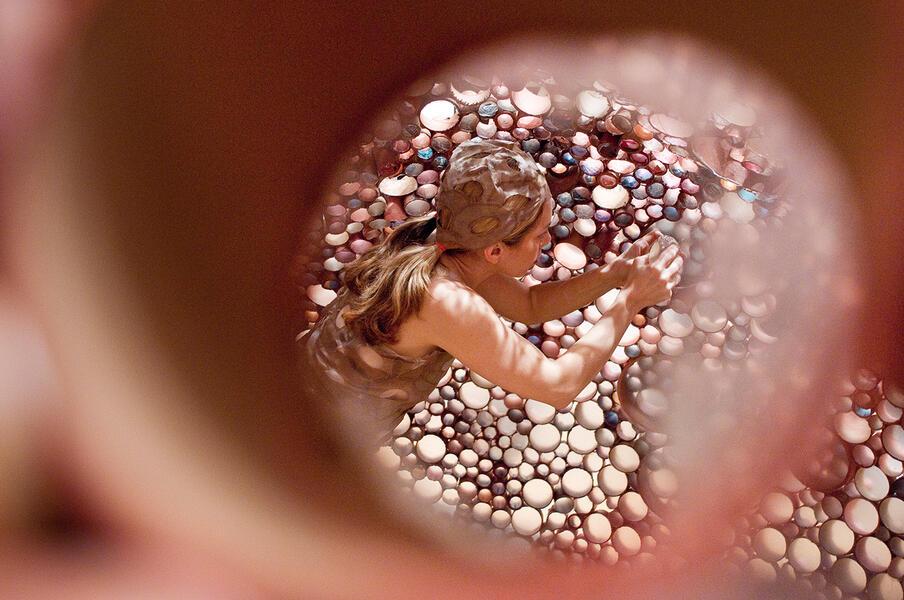 bouyantcardboard tubes, water-soluble plastic, water, paper, paint, glue, latex
bouyantcardboard tubes, water-soluble plastic, water, paper, paint, glue, latex -
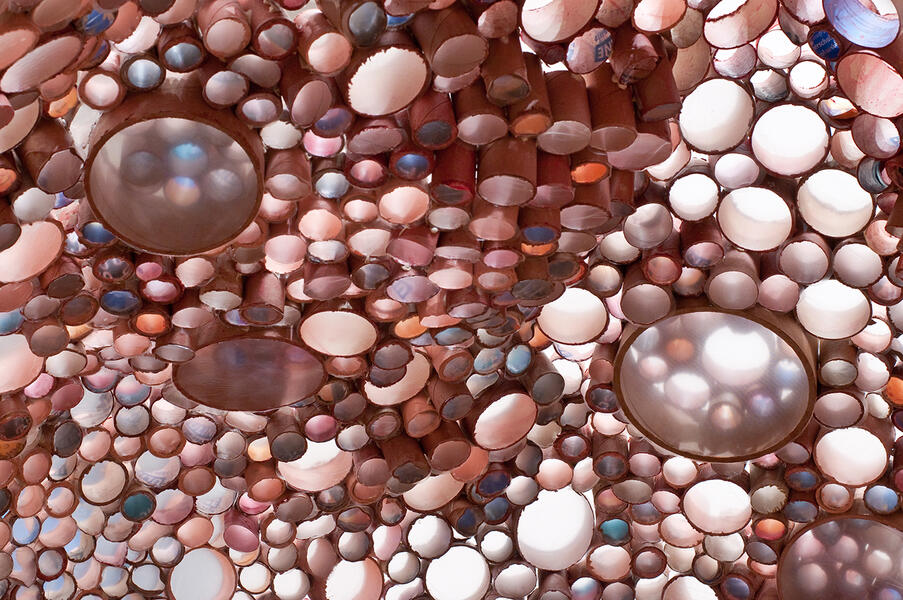 bouyantcardboard tubes, water-soluble plastic, water, paper, paint, glue, latex
bouyantcardboard tubes, water-soluble plastic, water, paper, paint, glue, latex -
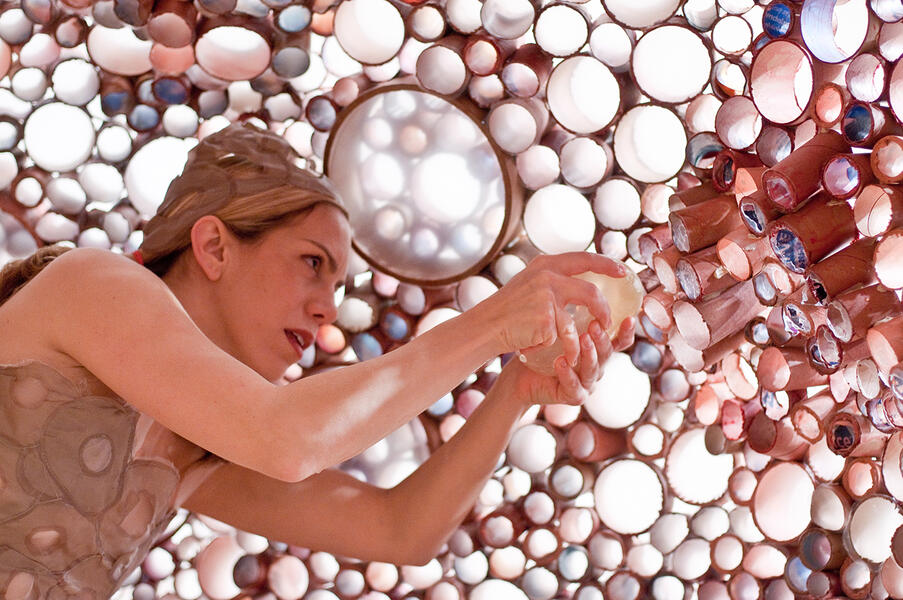 bouyantcardboard tubes, water-soluble plastic, water, paper, paint, glue, latex
bouyantcardboard tubes, water-soluble plastic, water, paper, paint, glue, latex -
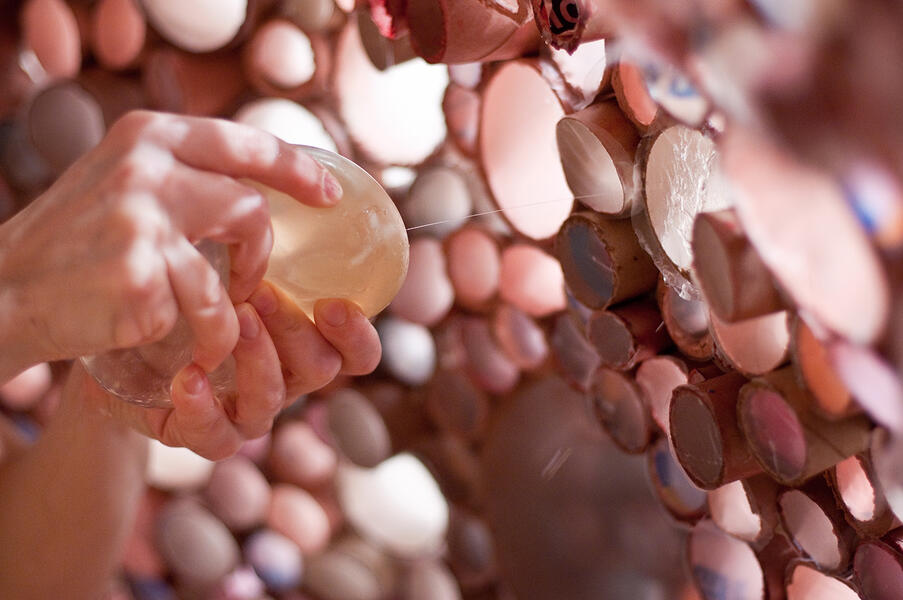 bouyantcardboard tubes, water-soluble plastic, water, paper, paint, glue, latex
bouyantcardboard tubes, water-soluble plastic, water, paper, paint, glue, latex -
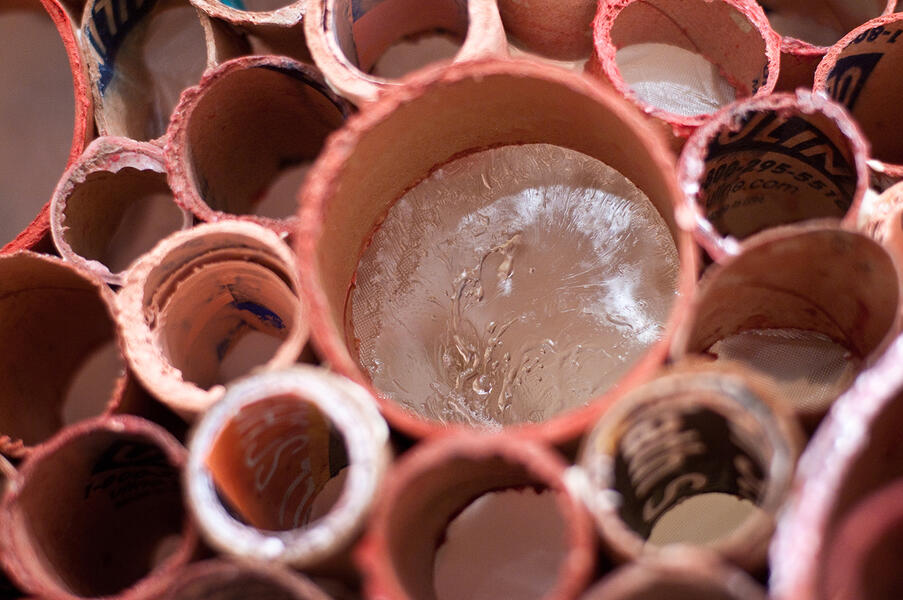 bouyantcardboard tubes, water-soluble plastic, water, paper, paint, glue, latex
bouyantcardboard tubes, water-soluble plastic, water, paper, paint, glue, latex -
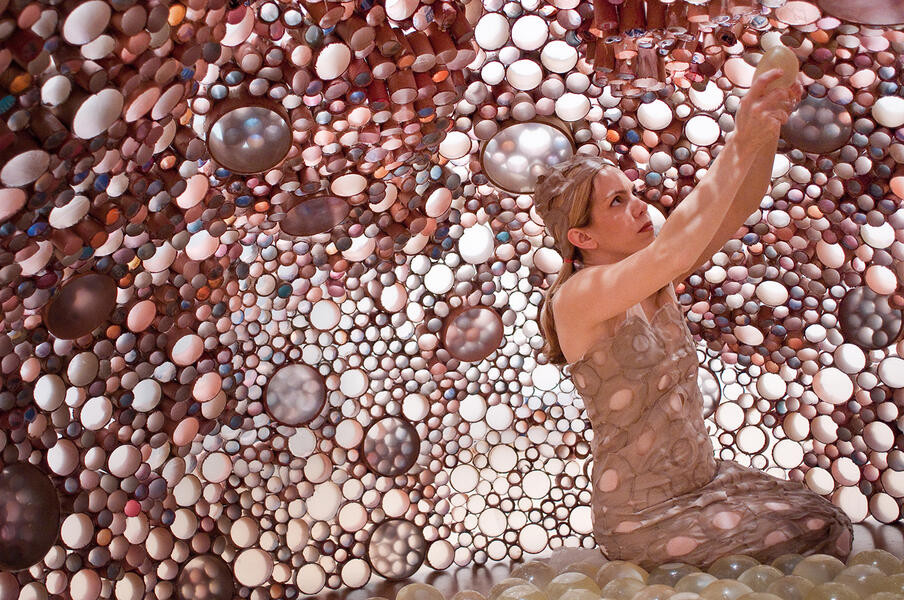 bouyantcardboard tubes, water-soluble plastic, water, paper, paint, glue, latex
bouyantcardboard tubes, water-soluble plastic, water, paper, paint, glue, latex -
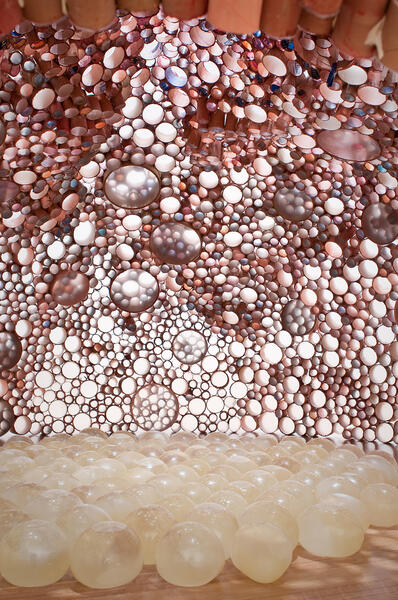 bouyantcardboard tubes, water-soluble plastic, water, paper, paint, glue, latex
bouyantcardboard tubes, water-soluble plastic, water, paper, paint, glue, latex -
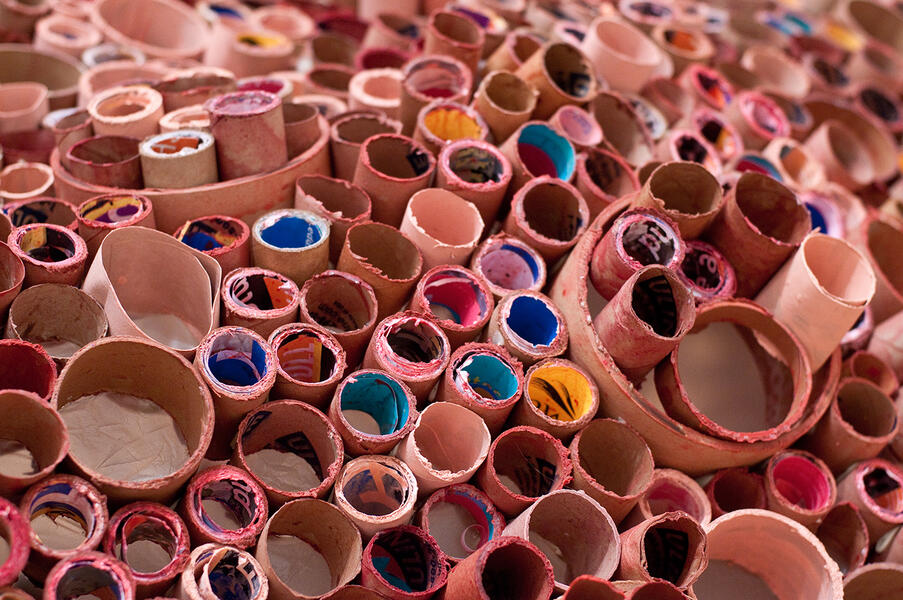 bouyantcardboard tubes, water-soluble plastic, water, paper, paint, glue, latex
bouyantcardboard tubes, water-soluble plastic, water, paper, paint, glue, latex -
bouyantAn eight-foot diameter dome constructed from cardboard tubes, paper, paint and glue occupied the gallery. The mouth of each tube was covered with a membrane of water-soluble plastic. During the performance I occupied the dome and used a small stream of water (from latex water balloons) to systematically dissolve each membrane. I began at the top of the dome and worked my way down the interior walls. From outside, as I progressed, my presence was revealed through various apertures in the tubes. The structure resembled a life-size snow globe with a gradually receding water level.
seep, ebb, and temper
sculptural installation and performance at the Biggs Building, Richmond, VA
I drew water from a basin, using a ladel that functioned as a sieve, and systematically dissolved my environment from hem to bodice. My activity began slowly and gracefully, drizzling water along the perimeter. As I progressed a puddle formed and grew larger, reflecting my activity and increasing the scale of the performance. Over time my movements became frenzied. I struggled to bring the telescoping ladel in close to my body before losing all of the water through the sieve. When the whole structure was dissolved, I lay down the ladel and retreated into the skirt structure, like a natilus, receding into its shell.
ebb
sculptural installation and performance at Hemphill Fine Arts, Washington, DC
Three cylindrical sculptures constructed from water-soluble plastic hung in the gallery. Each structure was comprised of three chambers. Using a reservoir of water attached to my abdomen, and a hand built implement, I melted the center of each circle. I activated the innermost chamber completely and then extended my implement through those holes in order to melt the second and thirs layers. Once the whole cylinder was activated, I tunneled my way out and into the neighboring structure.
temper
sculptural installation and performance at University of Maryland, College Park, MD
Cylinders made from water-soluble plastic were suspended from the ceiling and comprised a landscape in the gallery. The central cylinders were largest and closest to one another. As they moved out in space, the cylinders became thinner and were placed further apart. I occupied the largest cylinder, in the center of the gallery. Equipped with water in a modified sprayer, I sprayed a fine mist on the bottom of the cylinder closest to me. Once wet, the membrane of water-soluble plastic melted away, shedding the acetate ring that served as its base. I melted the cylinder from the bottom upwards, stopping at my approximate height. I repeated this gesture with each neighboring cylinder, starting close, and gradually extending the sprayer beyond my reach. As more structures were melted, a different landscape emerged. Gooey, sticky threads replaced clean orderly cylinders. Globs of water-soluble plastic slid down threads, sustaining perpetual motion left in my wake. My progress seemed to impede my progress as I had to disentangle myself more frequently for duration of the performance.
Artist Statement:
Insects encase themselves for protection, to create a place where metamorphosis can occur. Utilizing their own secretions, they produce raw materials from which they build. For me, the insect is a metaphor for human behavior. Like insects we are defined by the physical inevitability of our cycles of growth and reproduction, as well as our social need for physical labor.
I have explored these parallels by constructing sculptural costumes that encase my body and resemble cocoons, and then further developed these structures through performance. Exploring the concepts of change and transformation I encase myself in a structure that provides both a covering for my body, as well as a site for an activity. My motion is restricted, and I engage in a repeated action that involves the movement of a material from one part of the structure to another. This process alludes to cannibalism, and also imparts ideas of self-sufficiency implicit in such a closed system.
In one work, entitled Loop, I crocheted a cocoon of tubes to envelop my body like a circulatory system. I sucked on one end of the continuous circuit, drawing fluid from the other end of the long tube, anchored in a pouch on my belly. In another, Seep, my dress extended from my body to become a landscape, its perimeter far beyond my reach. I dipped a 12-foot ladle into a trough of water to slowly dissolve the dress from the hem to the bodice.
In these and in all of my works, the elements are constructed through a laborious process of weaving, braiding, or sewing. They are then activated in performance through a similar process of methodical alteration. I share the space intimately with my audience and communicate not only through sight and movement, but also sound and touch. Utilizing temporal materials such as gelatins, fluids, or water-soluble plastics, I speak to the notion of time and change. These are repetitive actions that build and transform a work, like a spider, strand by strand, spinning a web, or a wasp, layer by layer, building a nest.
-
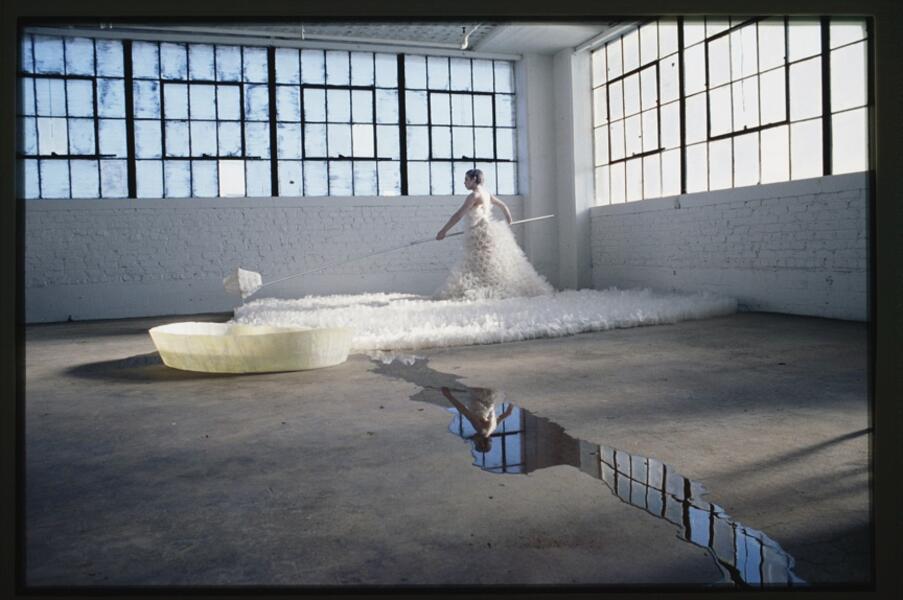 seepperformance utilizing water-soluble plastic, water, implements I drew water from a basin, using a ladle that functioned as a sieve, and systematically dissolved my environment from hem to bodice. My activity began slowly and gracefully, drizzling water along the perimeter. As I progressed in my task movements became more frenzied. I struggled to bring the telescoping ladle in close to my body before losing all of the water through the sieve.
seepperformance utilizing water-soluble plastic, water, implements I drew water from a basin, using a ladle that functioned as a sieve, and systematically dissolved my environment from hem to bodice. My activity began slowly and gracefully, drizzling water along the perimeter. As I progressed in my task movements became more frenzied. I struggled to bring the telescoping ladle in close to my body before losing all of the water through the sieve. -
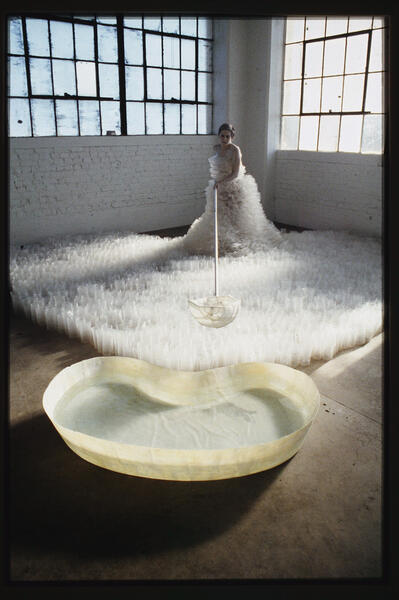 seepperformance utilizing water-soluble plastic, water, implements I drew water from a basin, using a ladle that functioned as a sieve, and systematically dissolved my environment from hem to bodice. My activity began slowly and gracefully, drizzling water along the perimeter. As I progressed in my task movements became more frenzied. I struggled to bring the telescoping ladle in close to my body before losing all of the water through the sieve.
seepperformance utilizing water-soluble plastic, water, implements I drew water from a basin, using a ladle that functioned as a sieve, and systematically dissolved my environment from hem to bodice. My activity began slowly and gracefully, drizzling water along the perimeter. As I progressed in my task movements became more frenzied. I struggled to bring the telescoping ladle in close to my body before losing all of the water through the sieve. -
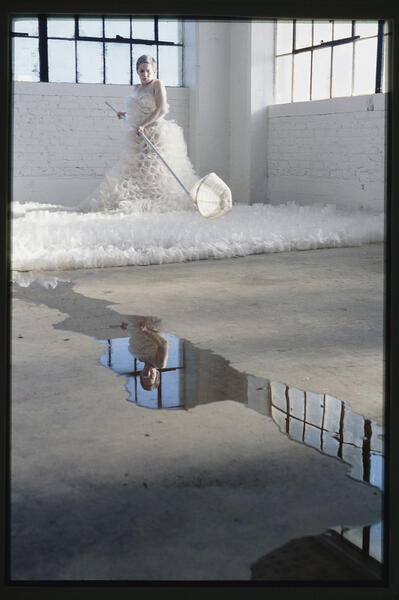 seepperformance utilizing water-soluble plastic, water, implements I drew water from a basin, using a ladle that functioned as a sieve, and systematically dissolved my environment from hem to bodice. My activity began slowly and gracefully, drizzling water along the perimeter. As I progressed in my task movements became more frenzied. I struggled to bring the telescoping ladle in close to my body before losing all of the water through the sieve.
seepperformance utilizing water-soluble plastic, water, implements I drew water from a basin, using a ladle that functioned as a sieve, and systematically dissolved my environment from hem to bodice. My activity began slowly and gracefully, drizzling water along the perimeter. As I progressed in my task movements became more frenzied. I struggled to bring the telescoping ladle in close to my body before losing all of the water through the sieve. -
seep documentationperformance utilizing water-soluble plastic, water, implements I drew water from a basin, using a ladle that functioned as a sieve, and systematically dissolved my environment from hem to bodice. My activity began slowly and gracefully, drizzling water along the perimeter. As I progressed in my task movements became more frenzied. I struggled to bring the telescoping ladle in close to my body before losing all of the water through the sieve.
-
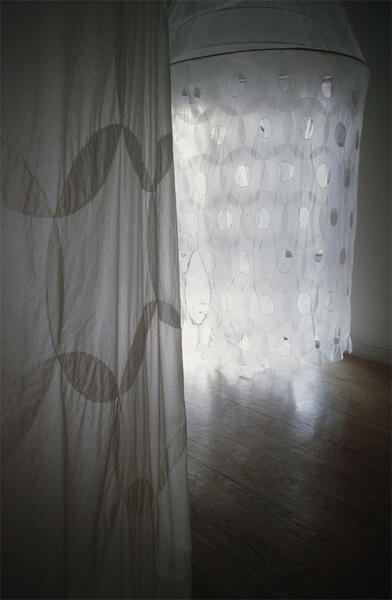 ebbperformance utilizing water-soluble plastic, water, implements Situated in the innermost chamber of three hanging cylinders I melted an aperture into the center of each water-soluble circle. Once the innermost chamber was fully activated I could reach my implement through the holes to melt the secondary (and later tertiary) holes. My progress revealed my presence throughout the performance. Once all three layers were activated I tunneled out and into the neighboring structure.
ebbperformance utilizing water-soluble plastic, water, implements Situated in the innermost chamber of three hanging cylinders I melted an aperture into the center of each water-soluble circle. Once the innermost chamber was fully activated I could reach my implement through the holes to melt the secondary (and later tertiary) holes. My progress revealed my presence throughout the performance. Once all three layers were activated I tunneled out and into the neighboring structure. -
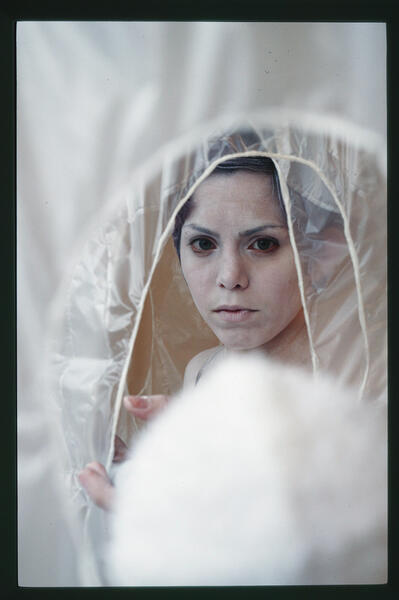 ebbperformance utilizing water-soluble plastic, water, implements Situated in the innermost chamber of three hanging cylinders I melted an aperture into the center of each water-soluble circle. Once the innermost chamber was fully activated I could reach my implement through the holes to melt the secondary (and later tertiary) holes. My progress revealed my presence throughout the performance. Once all three layers were activated I tunneled out and into the neighboring structure.
ebbperformance utilizing water-soluble plastic, water, implements Situated in the innermost chamber of three hanging cylinders I melted an aperture into the center of each water-soluble circle. Once the innermost chamber was fully activated I could reach my implement through the holes to melt the secondary (and later tertiary) holes. My progress revealed my presence throughout the performance. Once all three layers were activated I tunneled out and into the neighboring structure. -
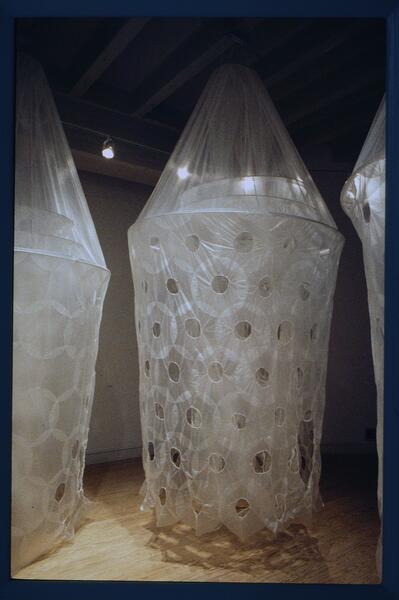 ebbperformance utilizing water-soluble plastic, water, implements Situated in the innermost chamber of three hanging cylinders I melted an aperture into the center of each water-soluble circle. Once the innermost chamber was fully activated I could reach my implement through the holes to melt the secondary (and later tertiary) holes. My progress revealed my presence throughout the performance. Once all three layers were activated I tunneled out and into the neighboring structure.
ebbperformance utilizing water-soluble plastic, water, implements Situated in the innermost chamber of three hanging cylinders I melted an aperture into the center of each water-soluble circle. Once the innermost chamber was fully activated I could reach my implement through the holes to melt the secondary (and later tertiary) holes. My progress revealed my presence throughout the performance. Once all three layers were activated I tunneled out and into the neighboring structure. -
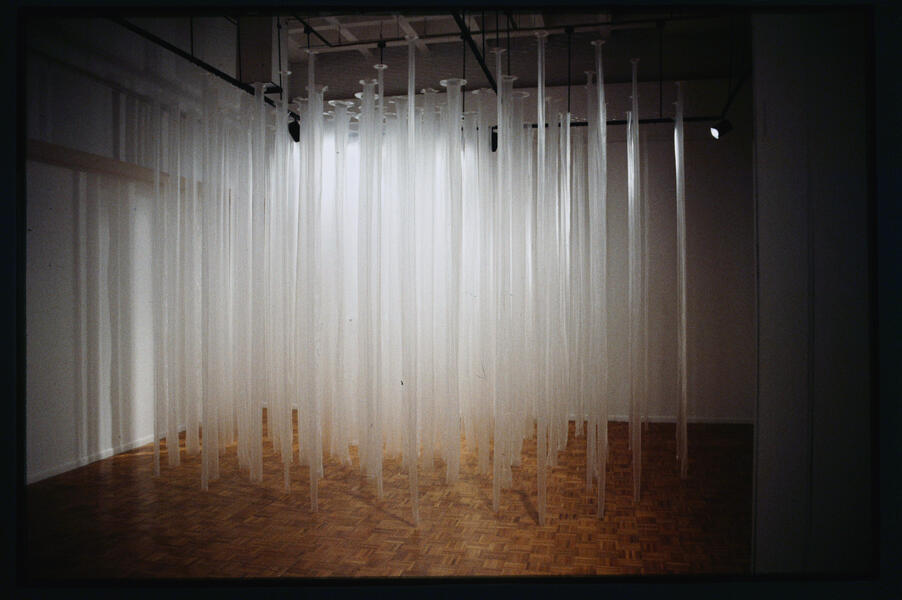 temper1.jpgtemper
temper1.jpgtemper -
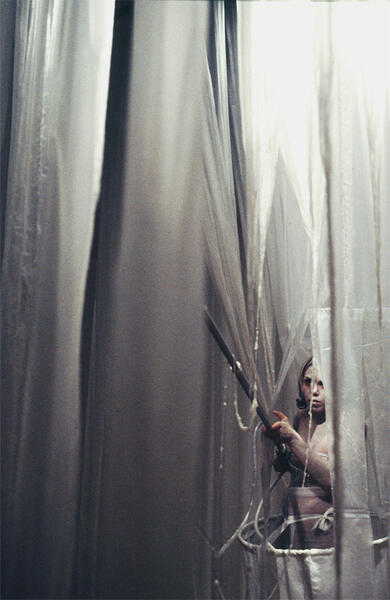 temperwater-soluble plastic, water, implements
temperwater-soluble plastic, water, implements -
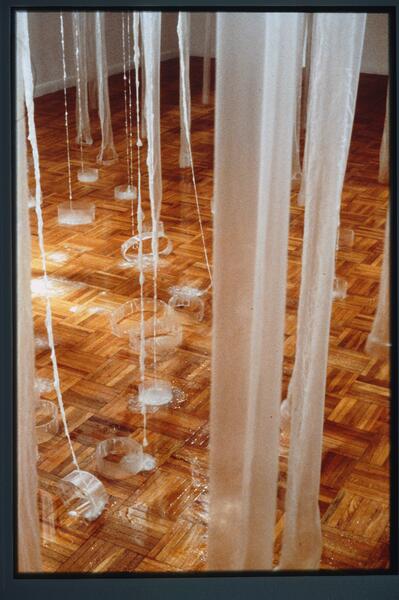 temper4.jpgtemper (detail)
temper4.jpgtemper (detail)
hair pieces and loop
loop
Exploring the concepts of change and transformation I encased myself in a structure that provided both a covering for my body, as well as a site for an activity. My motion was restricted, and I engaged in a repeated action that involved the movement of a material from one part of the structure to another. This process alluded to cannibalism, and also imparted ideas of self-sufficiency implicit in such a closed system.
In loop, I crocheted a cocoon of tubes to envelop my body like a circulatory system. I sucked on one end of the continuous circuit, drawing fluid from the other end of the long tube, anchored in a pouch on my belly.
hives, bristle, node, breathe (hair pieces)
Insects encase themselves for protection, to create a place where metamorphosis can occur. Utilizing their own secretions, they produce raw materials from which they build. For me, the insect is a metaphor for human behavior. Like insects we are defined by the physical inevitability of our cycles of growth and reproduction, as well as our social need for physical labor.
I have explored these parallels by constructing sculptural costumes that encase my body and resemble cocoons, and then further developed these structures through performance. Exploring the concepts of change and transformation I encase myself in a structure that provides both a covering for my body, as well as a site for an activity. My motion is restricted, and I engage in a repeated action that involves the movement of a material from one part of the structure to another. This process alludes to cannibalism, and also imparts ideas of self-sufficiency implicit in such a closed system.
In one work, entitled loop, I crocheted a cocoon of tubes to envelop my body like a circulatory system. I sucked on one end of the continuous circuit, drawing fluid from the other end of the long tube, anchored in a pouch on my belly. In another, Seep, my dress extended from my body to become a landscape, its perimeter far beyond my reach. I dipped a 12-foot ladle into a trough of water to slowly dissolve the dress from the hem to the bodice.
In these and in all of my works, the elements are constructed through a laborious process of weaving, braiding, or sewing. They are then activated in performance through a similar process of methodical alteration. I share the space intimately with my audience and communicate not only through sight and movement, but also sound and touch. Utilizing temporal materials such as gelatins, fluids, or water-soluble plastics, I speak to the notion of time and change. These are repetitive actions that build and transform a work, like a spider, strand by strand, spinning a web, or a wasp, layer by layer, building a nest.
lure & decoy / hem & swell
crocheted fishing line
A decidedly manmade material behaves like something organic. Serving as a giant fiber optic under direct light, the subtle piece demands attention from a distance, and alludes to a fishing lure.
lure was a companion piece to decoy. Drawings represented the shape-shifting properties of the crocheted fishing line sculpture, and served as a decoy to the sculpture in a concurrent exhibition.
decoy
ink and pencil
8"x10" drawings on shrinkable plastic were shrunk down to approximately 2"x3"
decoy was a companion piece to lure. Drawings represented the shape-shifting properties of the crocheted fishing line sculpture sculpture, and served as a decoy to the sculpture in a concurrent exhibition.
decoy was inspired by the poet, Amy Eisner, and was created in tandem with two of her poems.
hem
aluminum window screening, vinyl, zip ties, grommets, insects
Three trees were sheathed in accordian-folded aluminum window screening.
Screening, a material that was designed to keep insects out of the human environment was introduced into insects' natural habitat.
Highly reflective in sunlight and nearly invisible in shadow, hem addressed issues of visibility and invisibility.
swell
plastic cups, zip ties
Three trees were sheathed in structures constructed from plastic cups and zip ties. Each had a protusion, or swell, like a snake digesting an egg. These structures served as a habitat for cicadas, mosquitoes, and hornets during the five month exhibition. When I thought I was taking a break from performative work, insects became the performers.
-
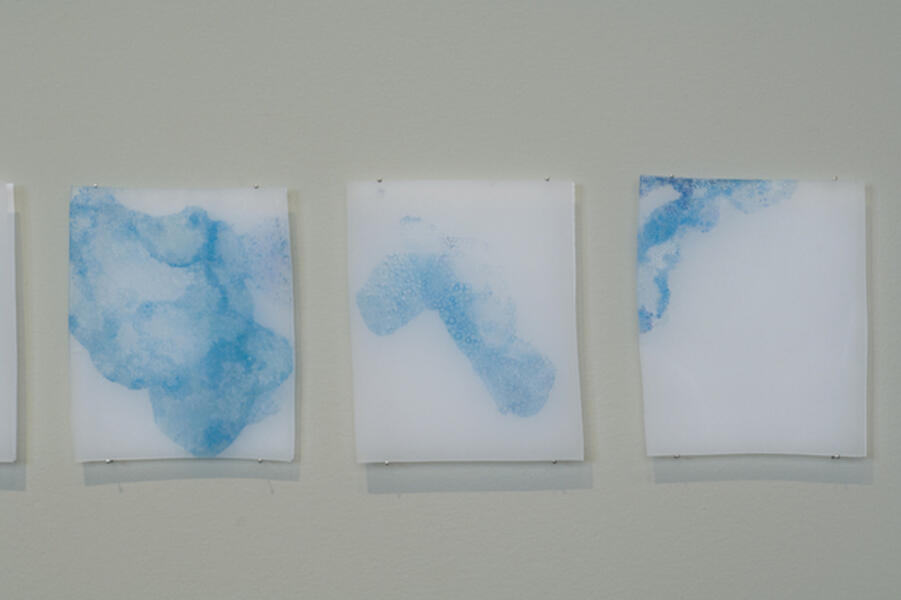 decoycolored pencil and ink on shrinkable plastic
decoycolored pencil and ink on shrinkable plastic -
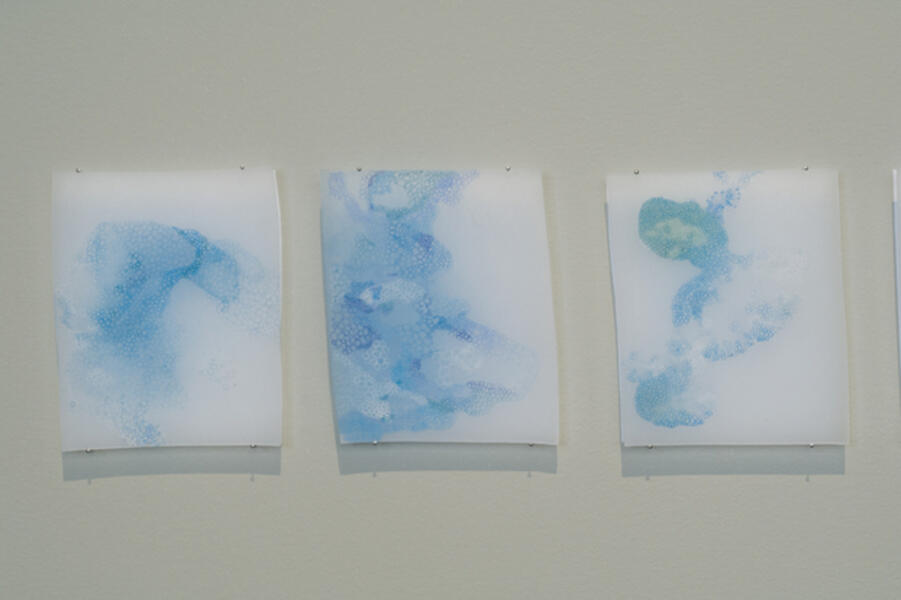 decoy_2.jpg
decoy_2.jpg -
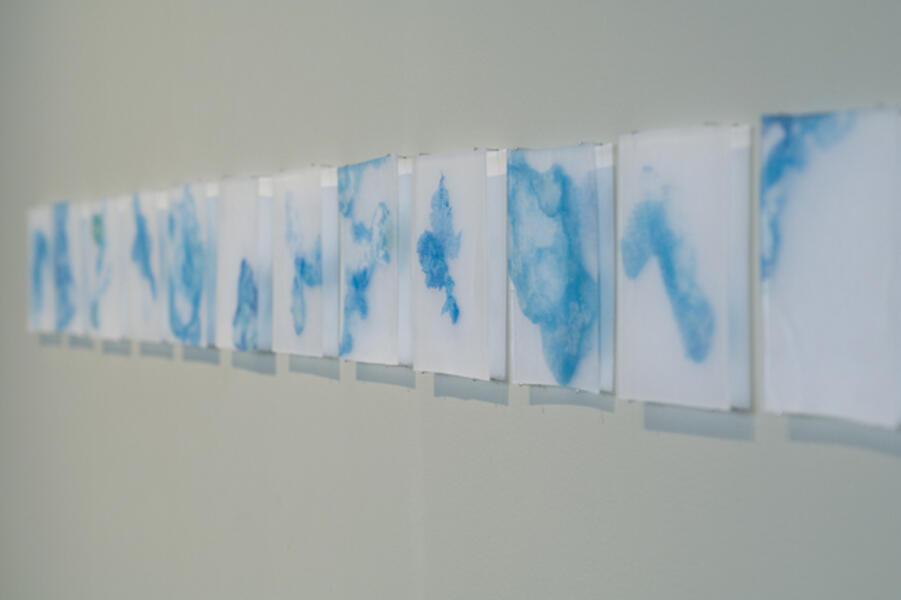 decoy
decoy -
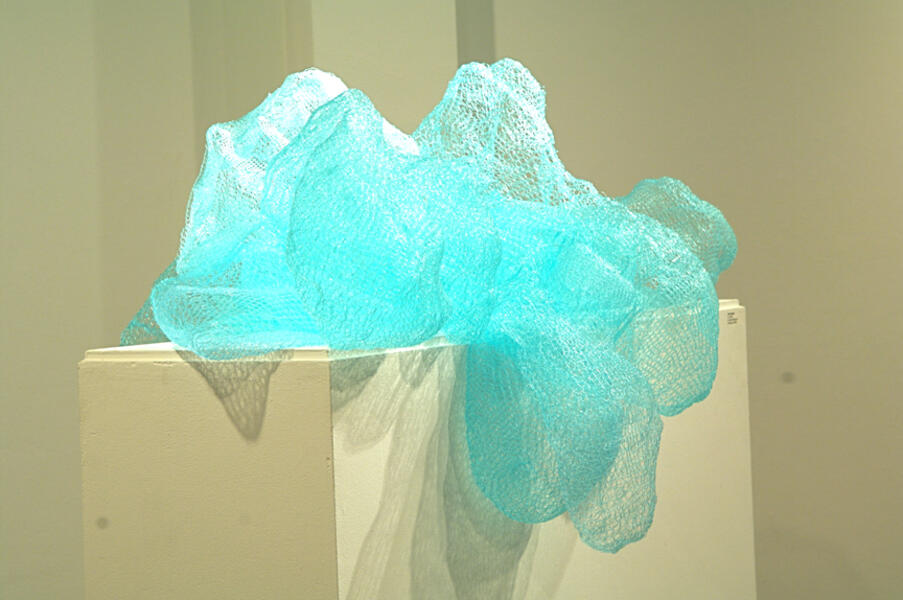 lurecrocheted fishing line
lurecrocheted fishing line -
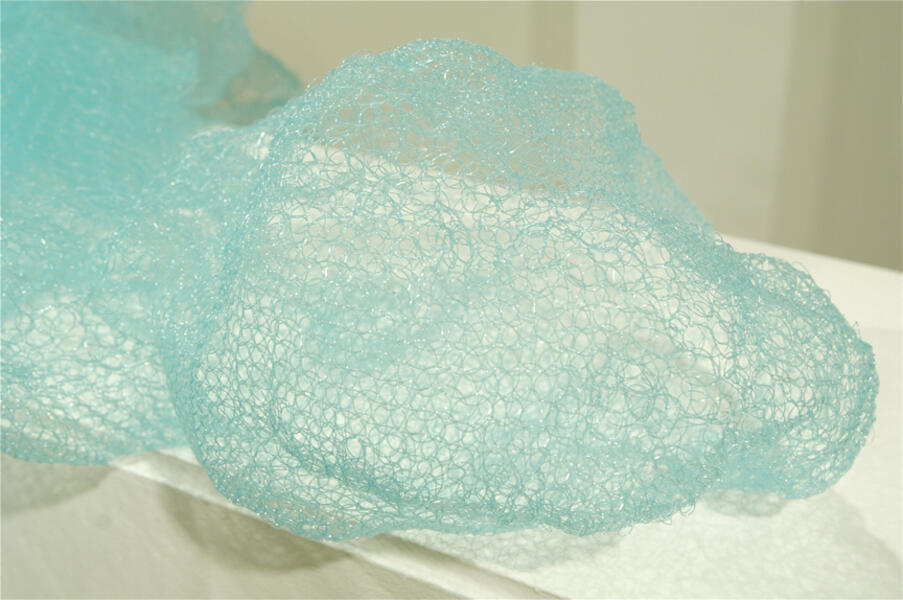 lurecrocheted fishing line
lurecrocheted fishing line -
swell3.JPGswell
-
swell1.JPGswell
-
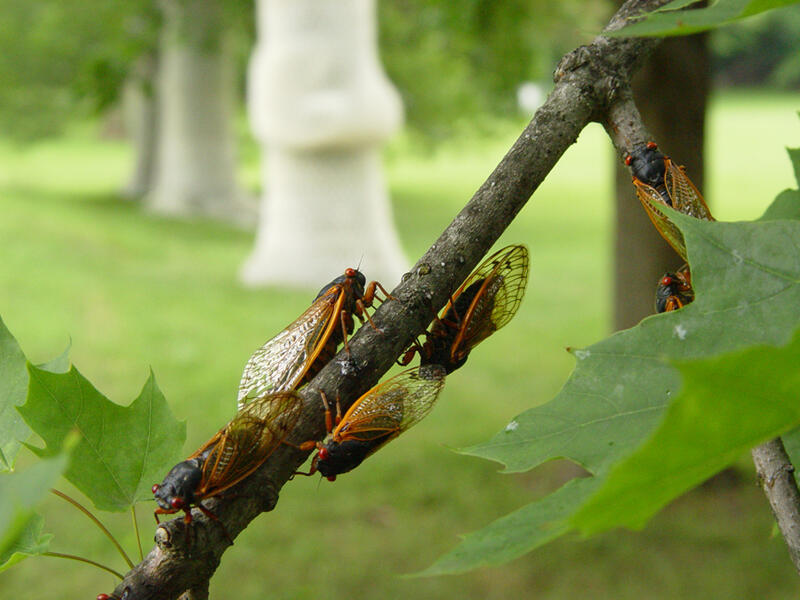 swellTrees were encased in sheaths of plastic cups and cable ties. The plastic structures stood approximately 20ft. high and were inhabited by cicadas over the five month exhibition.
swellTrees were encased in sheaths of plastic cups and cable ties. The plastic structures stood approximately 20ft. high and were inhabited by cicadas over the five month exhibition. -
hemAccordion-pleated aluminum window screening sheathed three trees. Over a period of several months, a material designed to keep insects out of human environments became a temporary dwelling for insects.
-
hemAccordion-pleated aluminum window screening sheathed three trees. Over a period of several months, a material designed to keep insects out of human environments became a temporary dwelling for insects.
wake and vent
Vent also referenced a field (or transplanted pool), employed a mechanic's cart, and mimicked travel through water. On the cart, I appeared to glide as if underwater, while creating small vents in the surface membrane. I drew water in through a length of tube and used my own respiration to propel water vertically though the center of each bubble-shaped form. The activity alluded to the natural world, suggesting a whale purging its blow hole, but the geometry, lighting, and handiwork of the sculpture were unequivocally human.







































